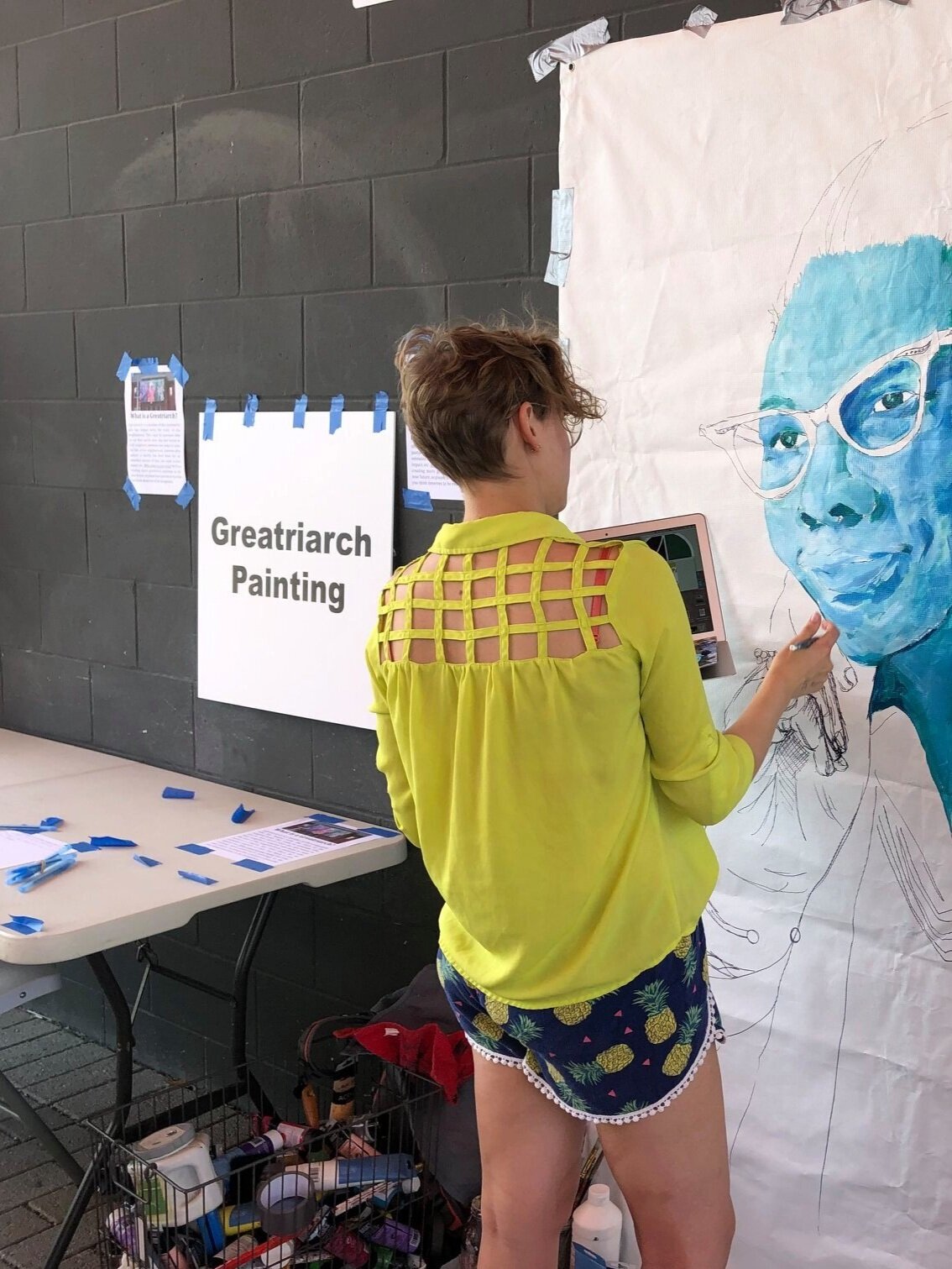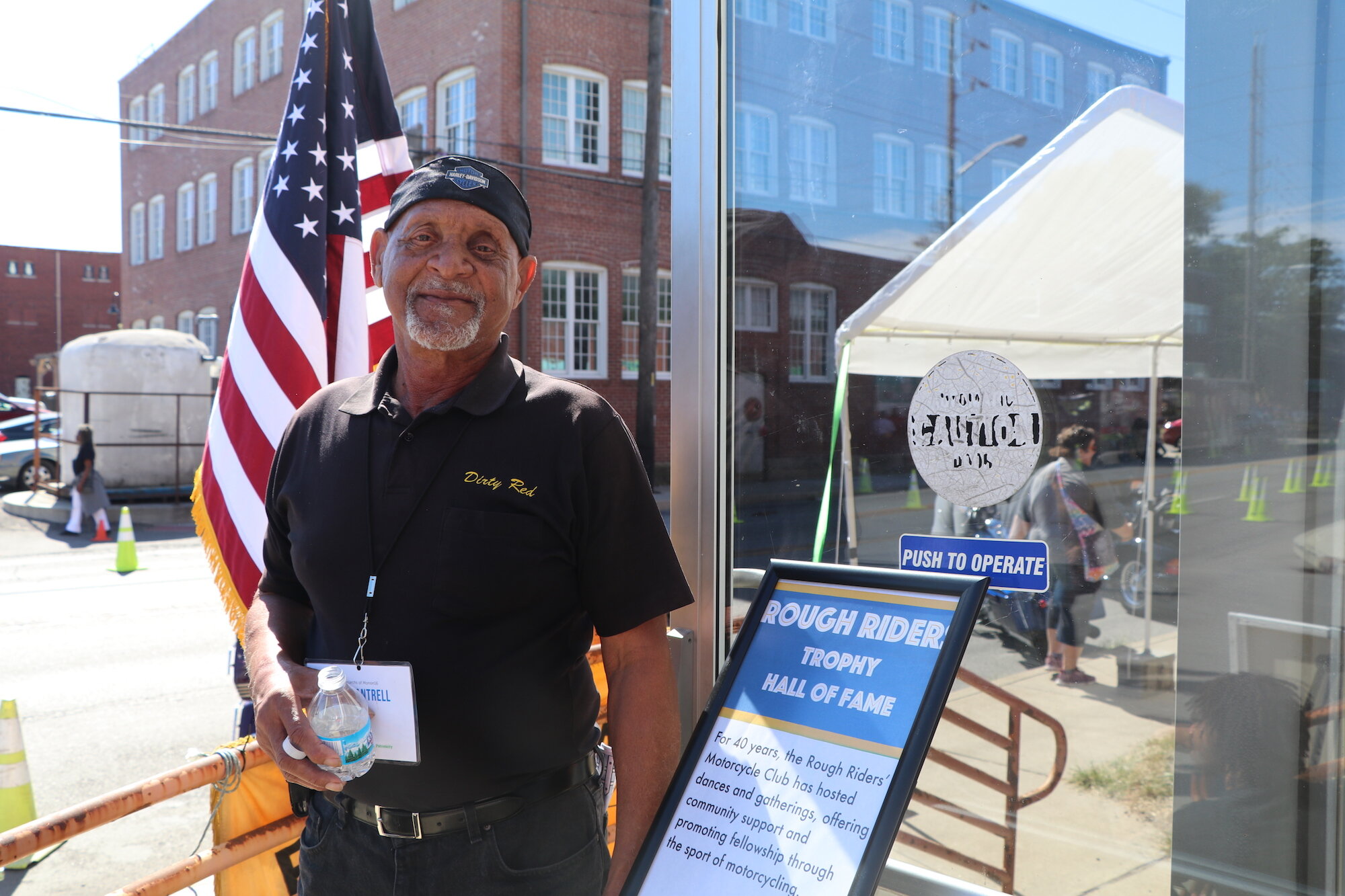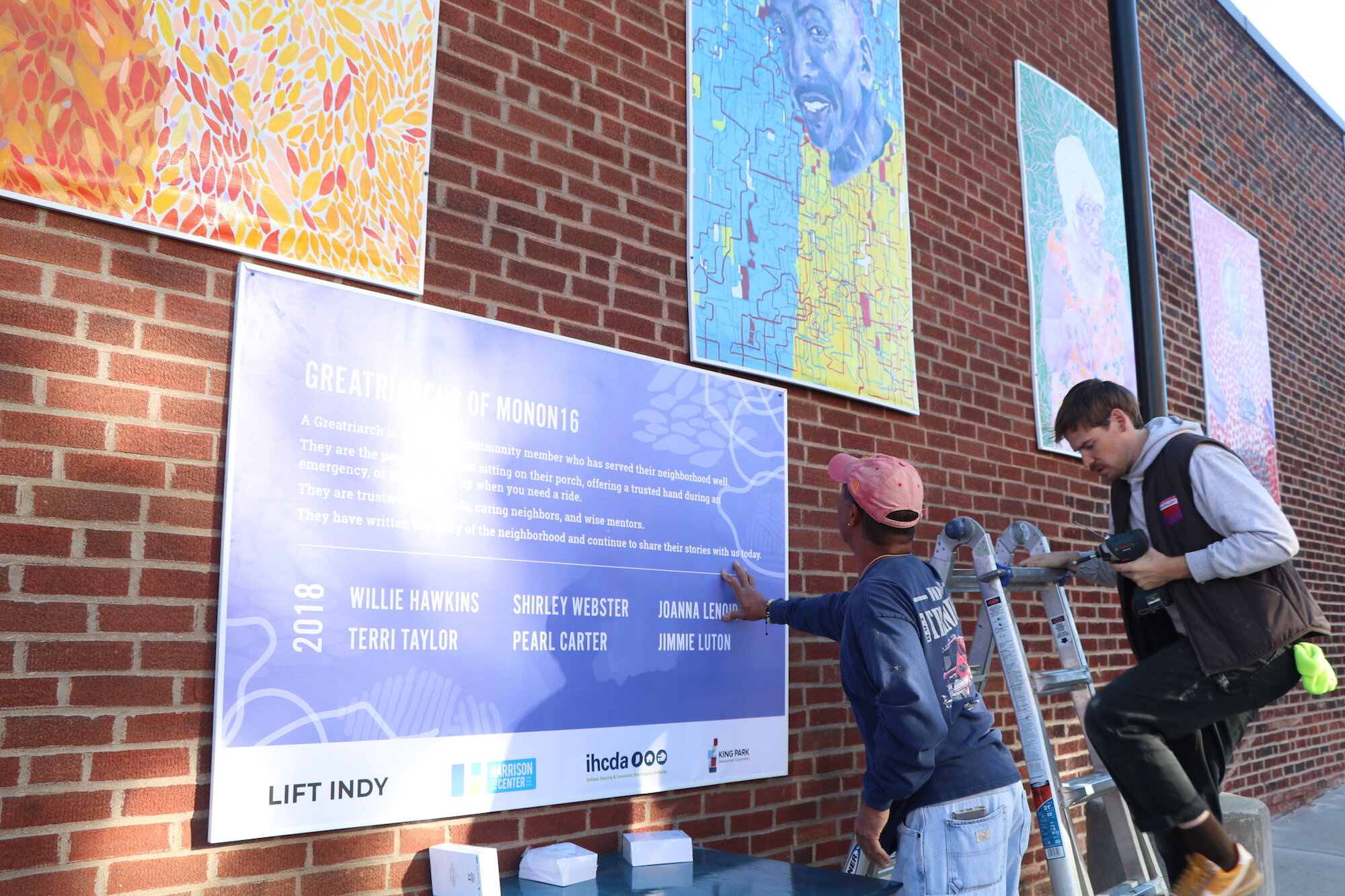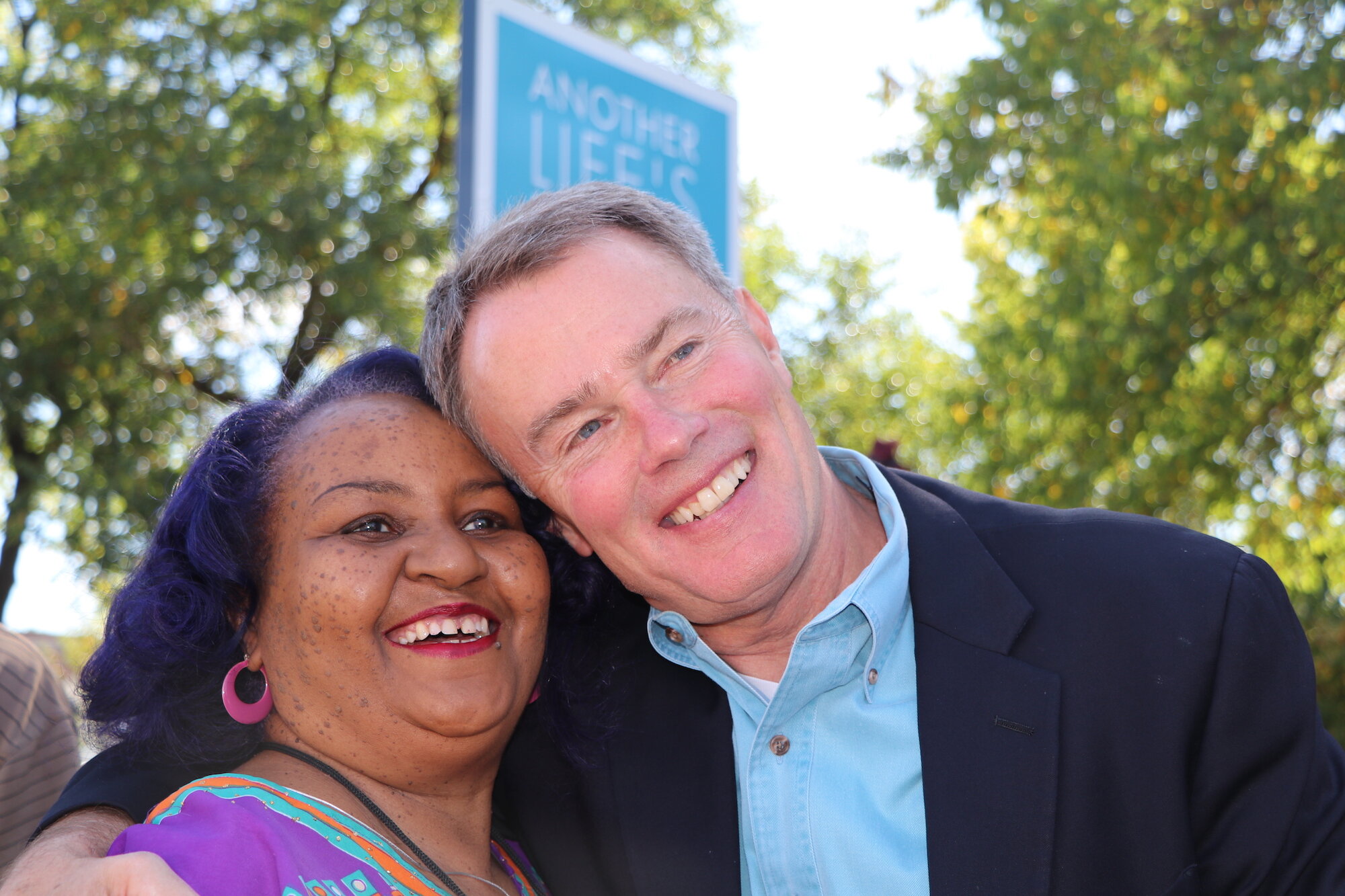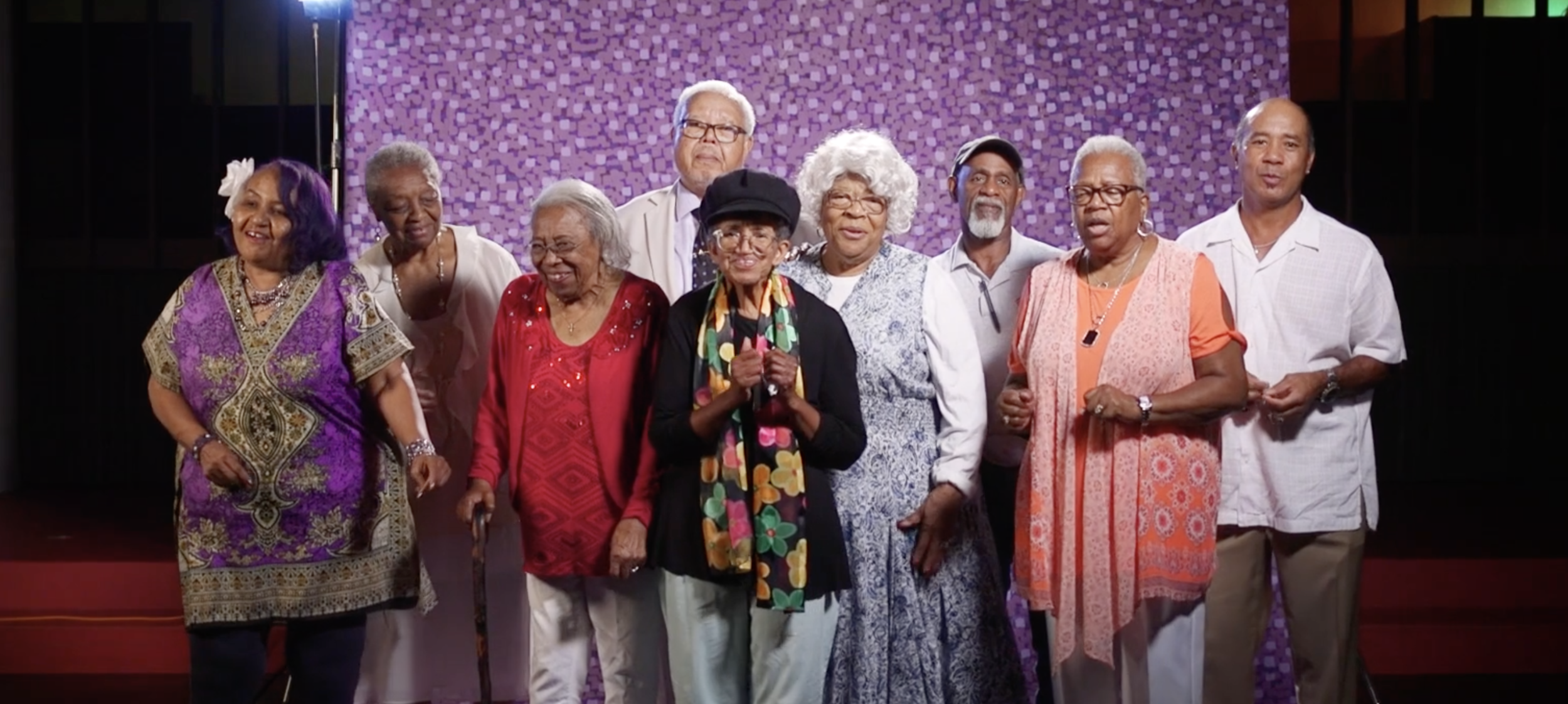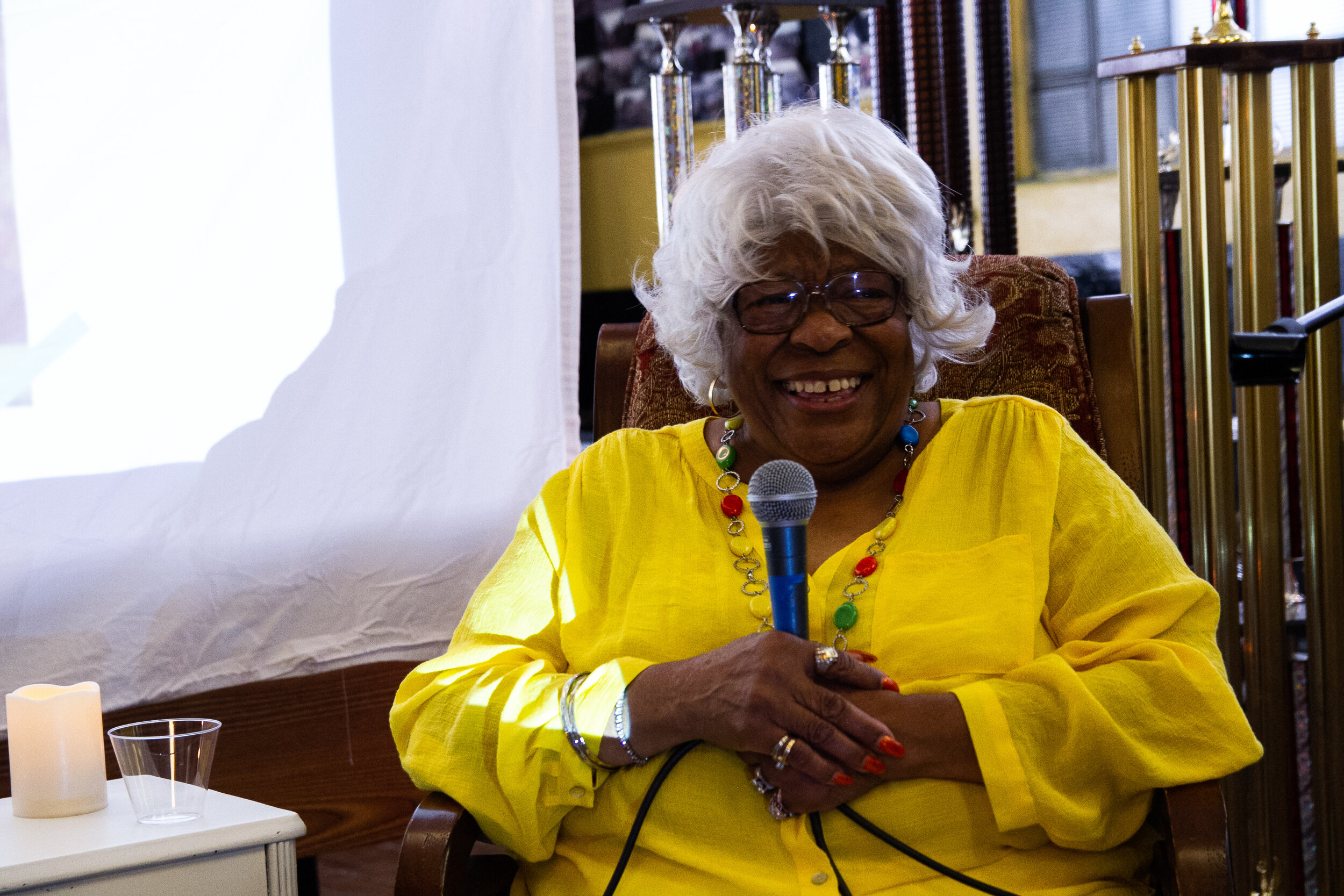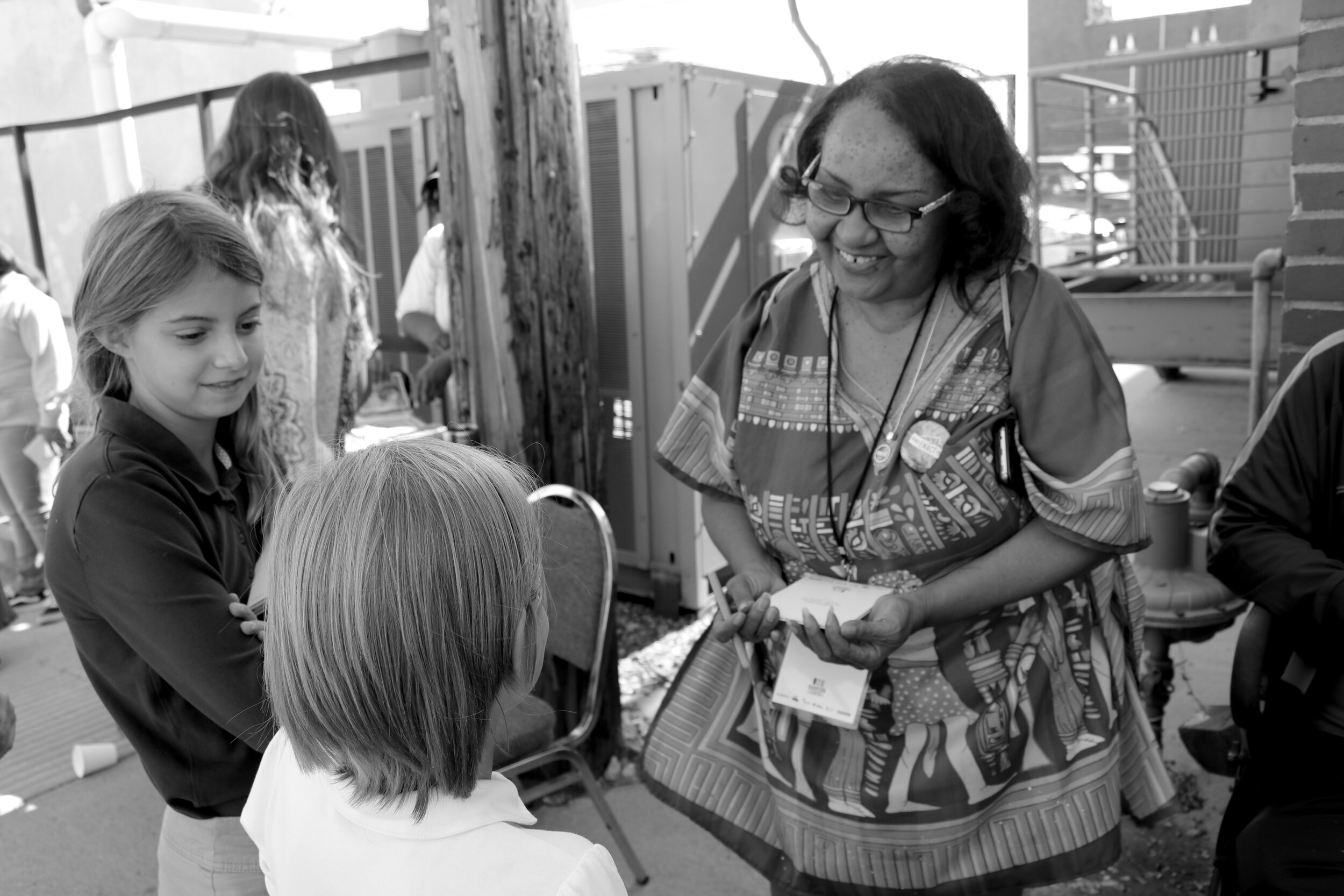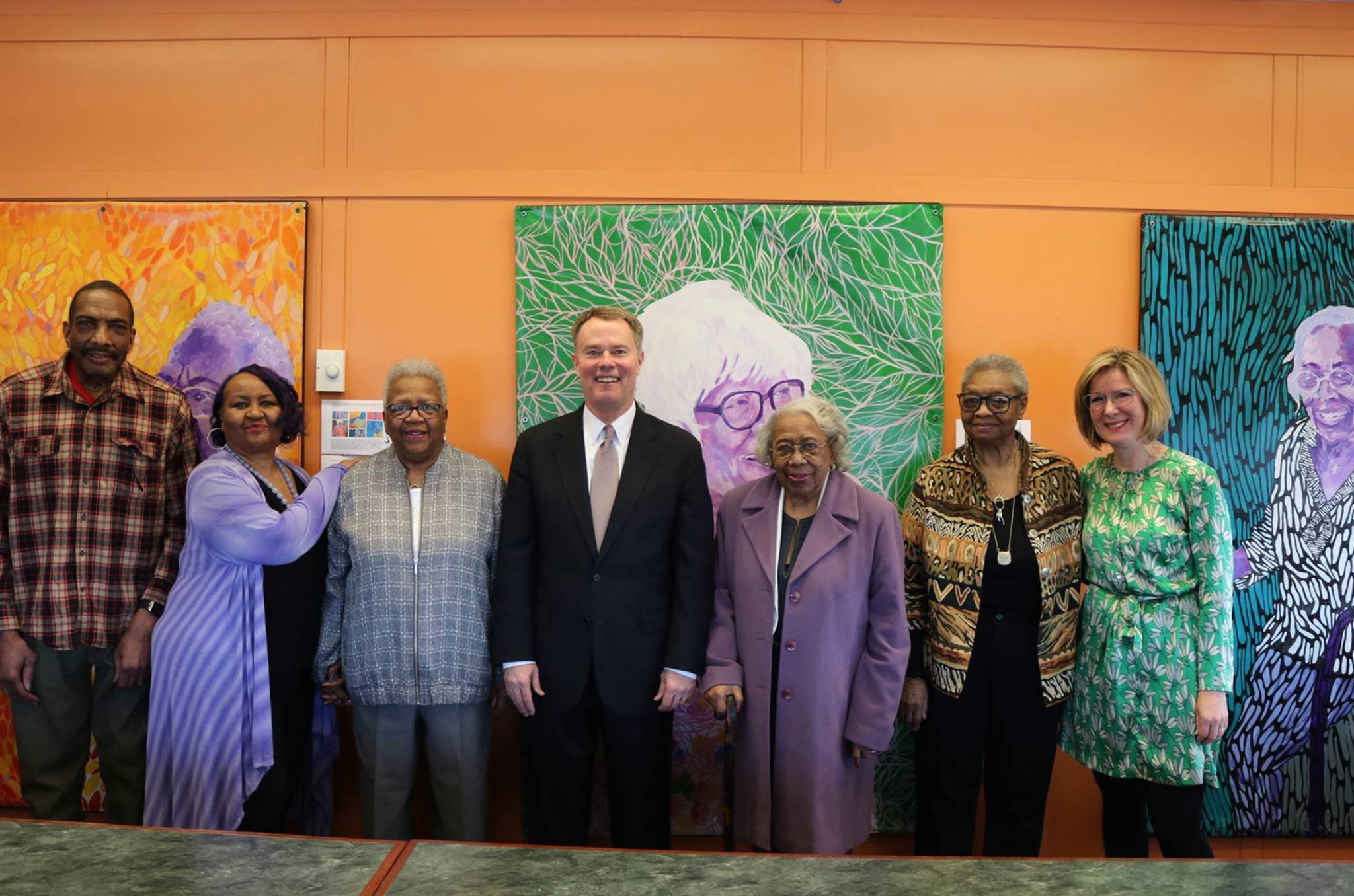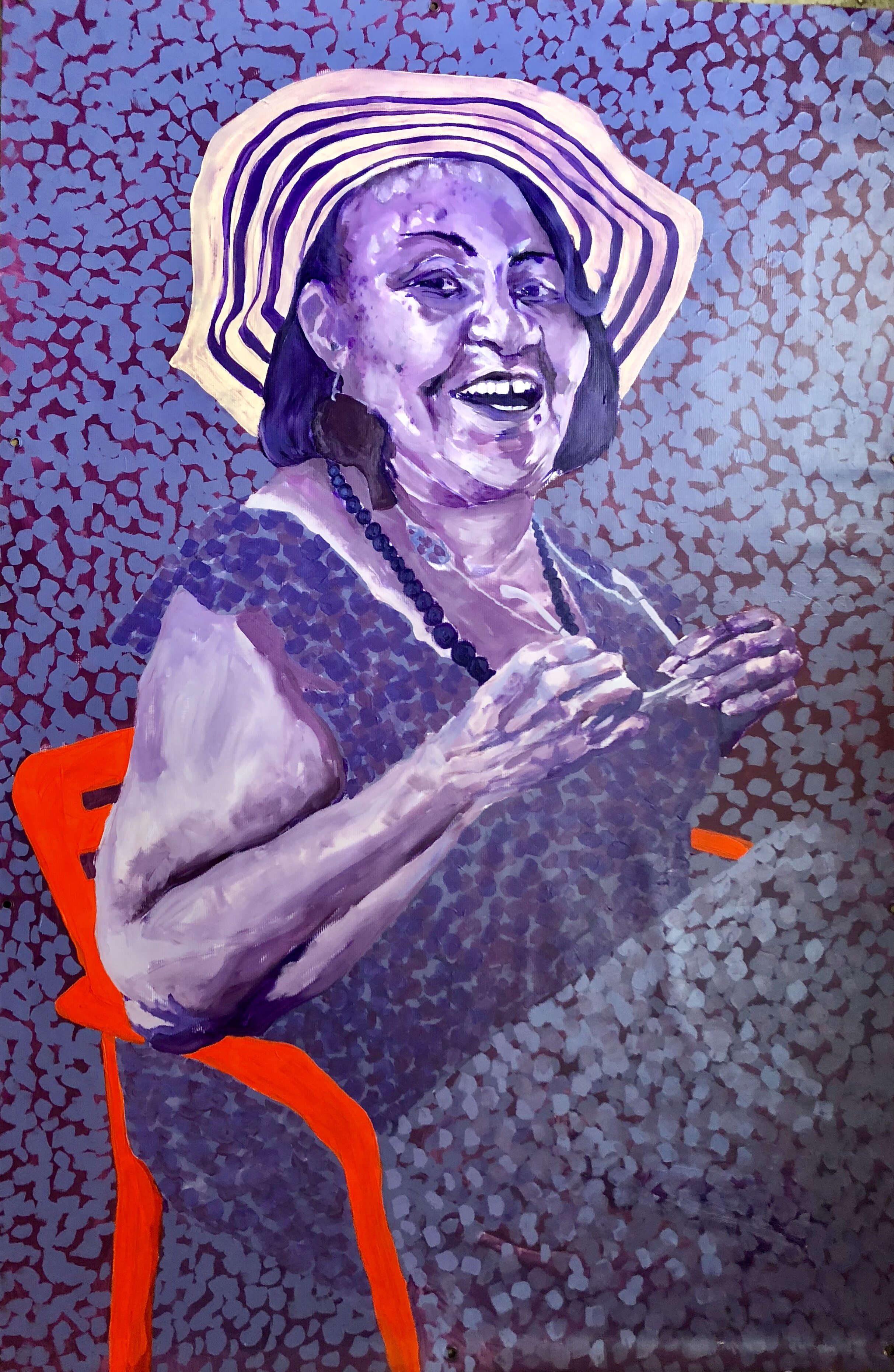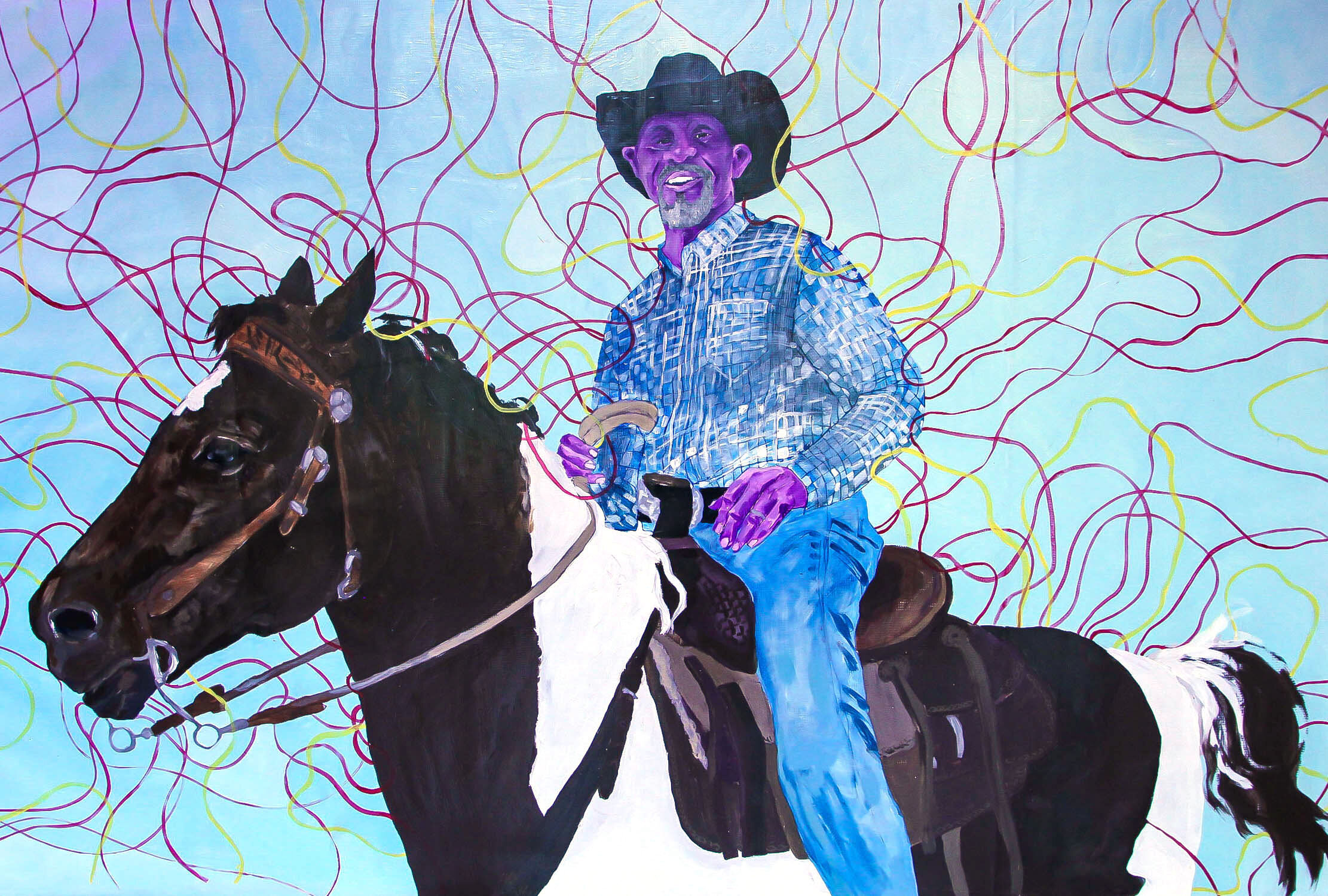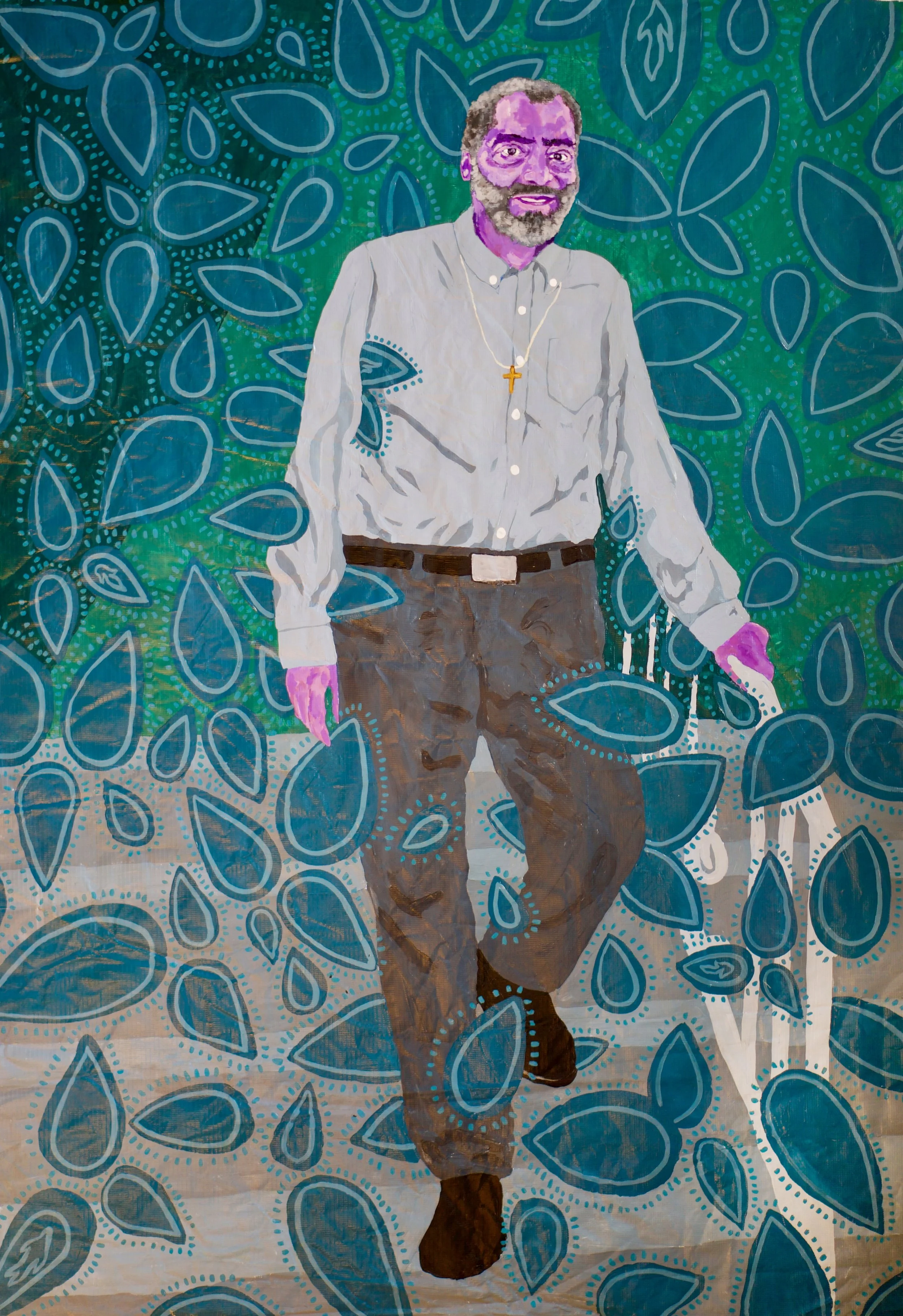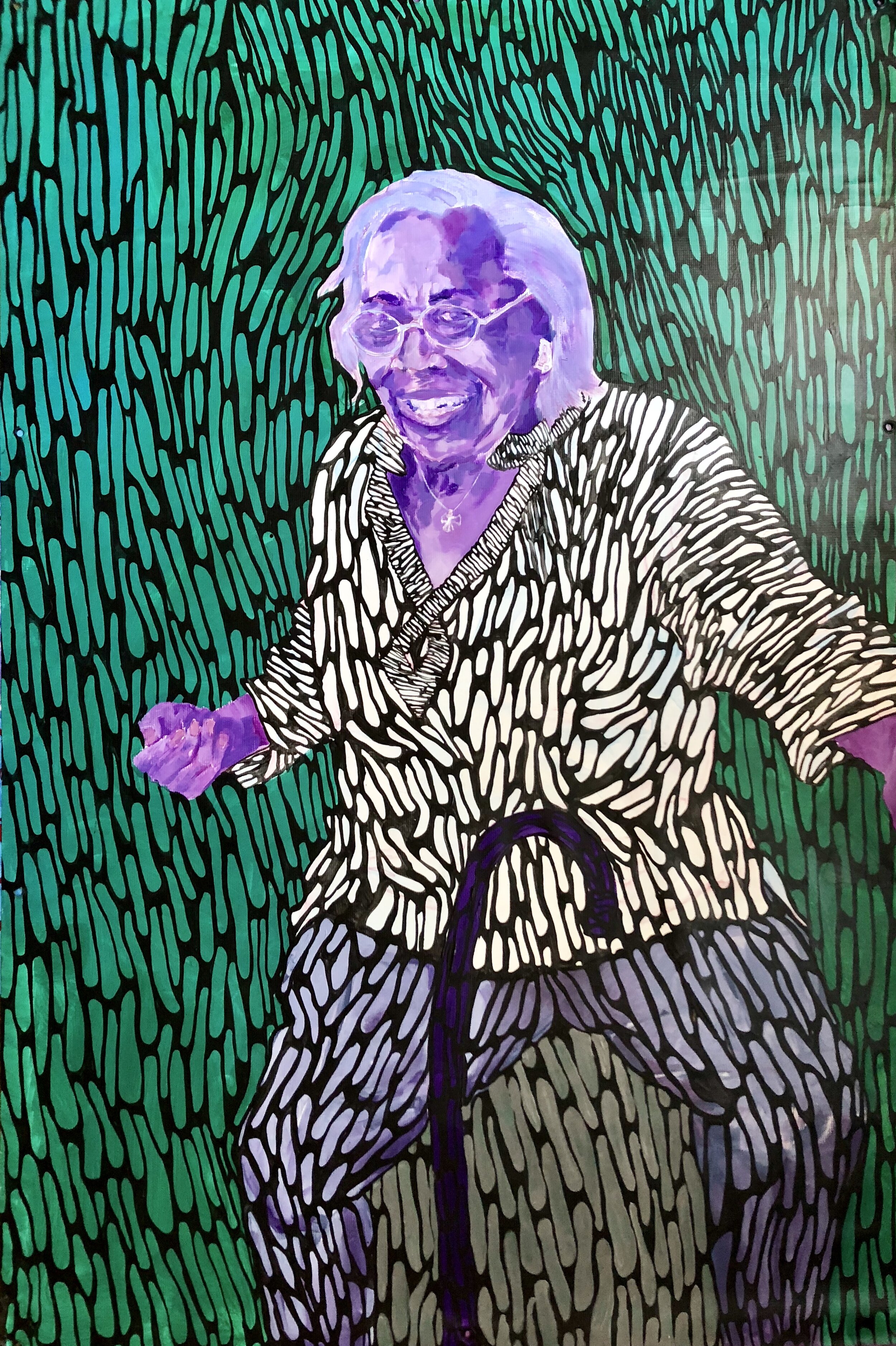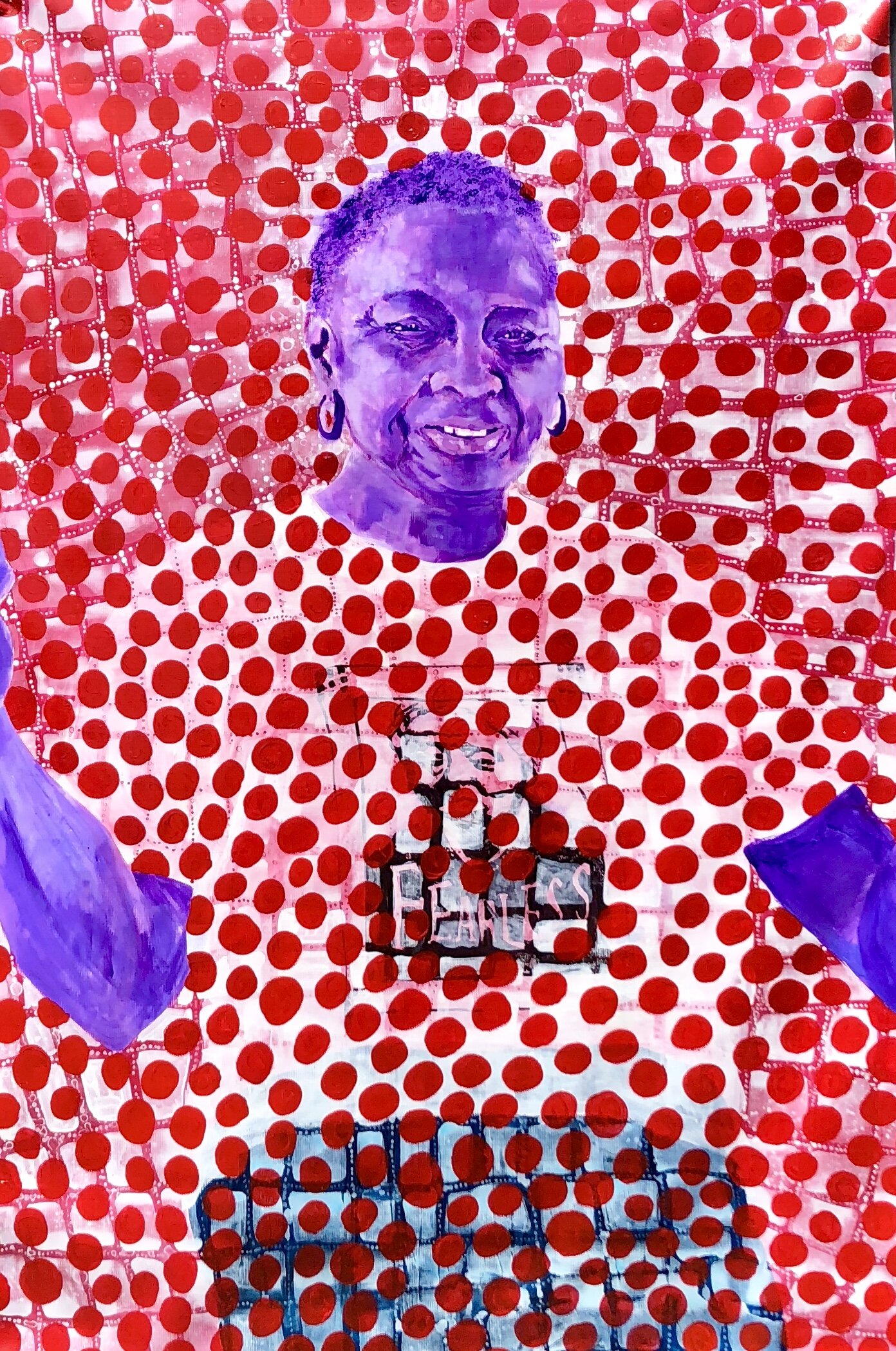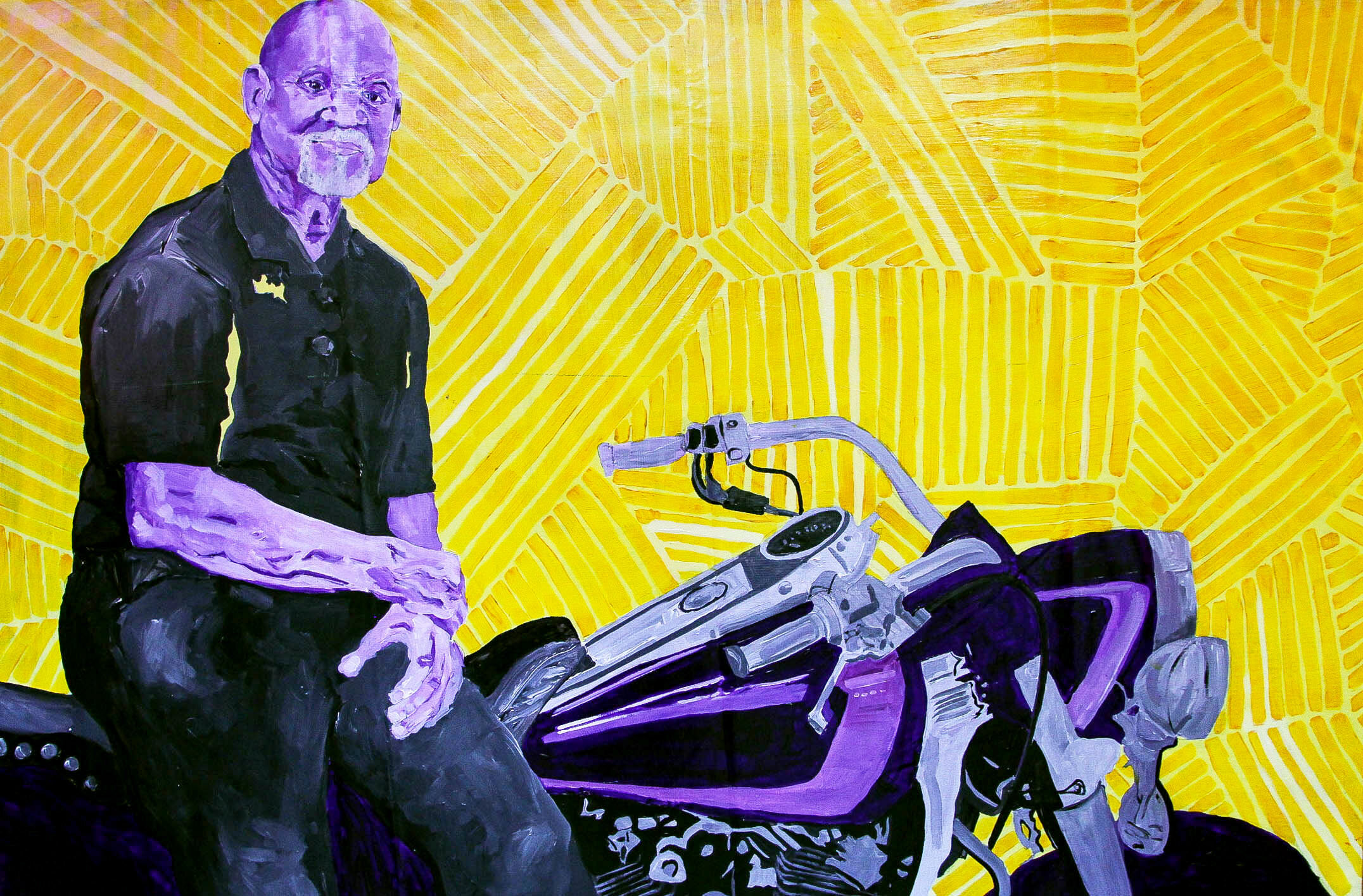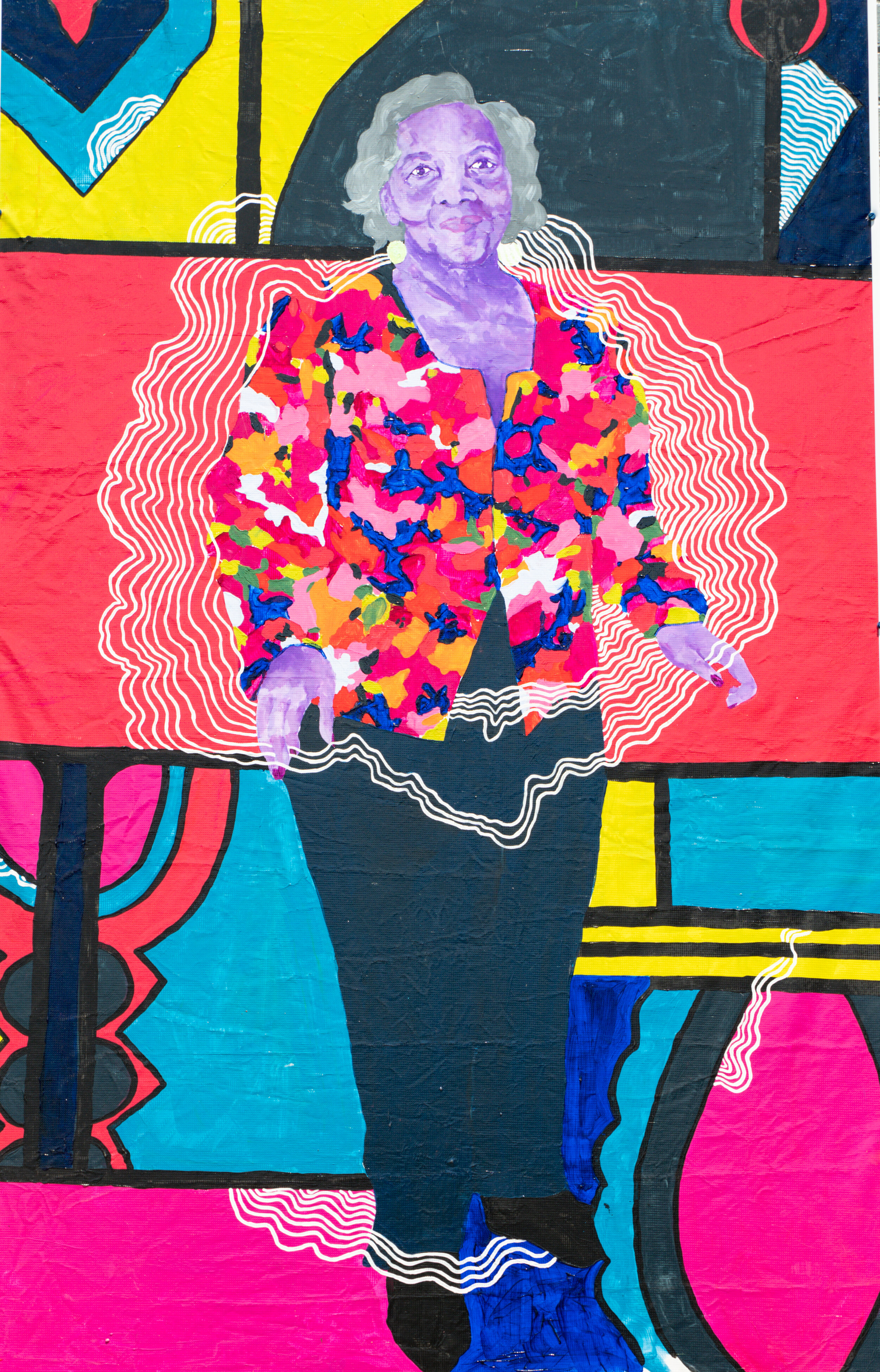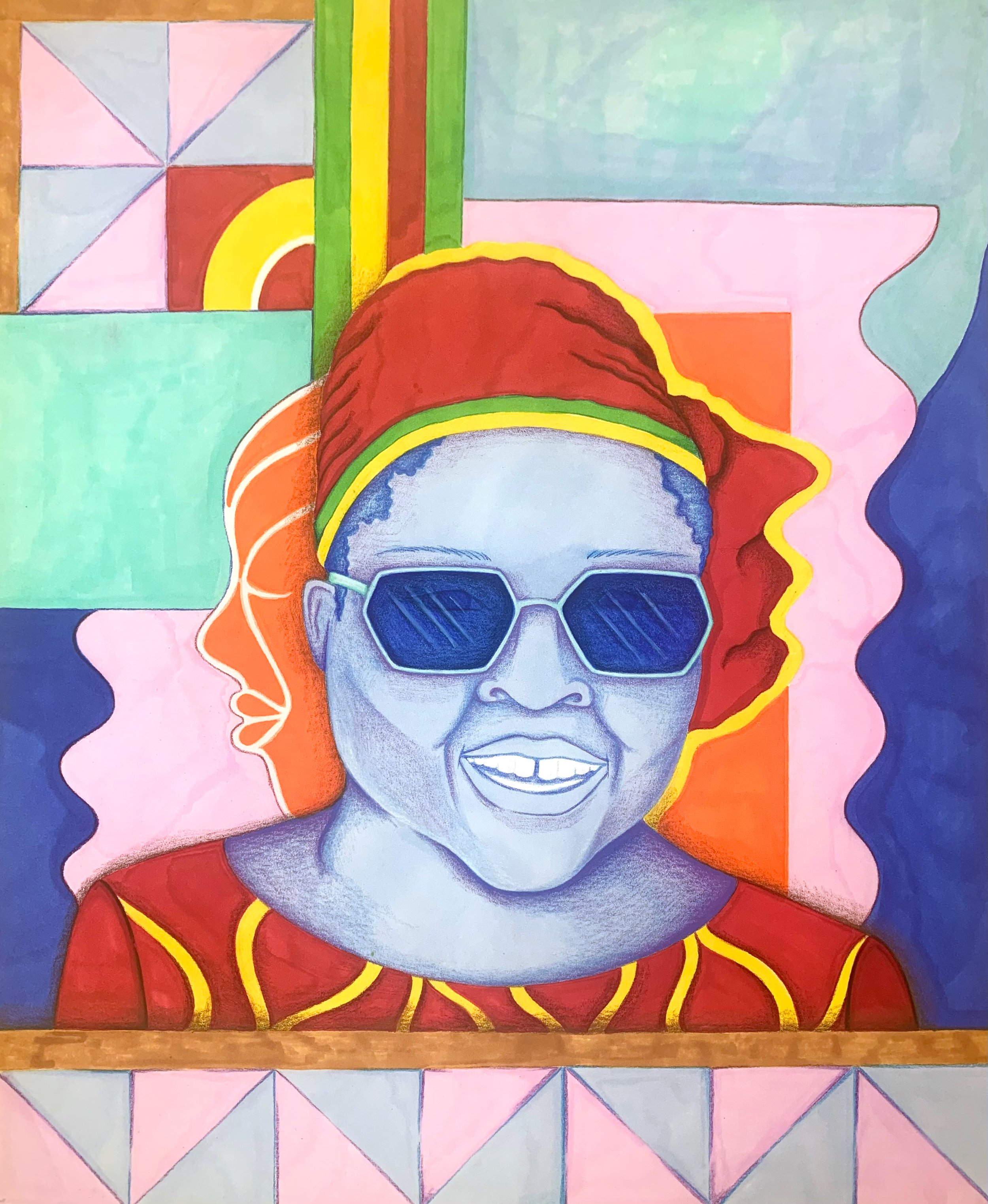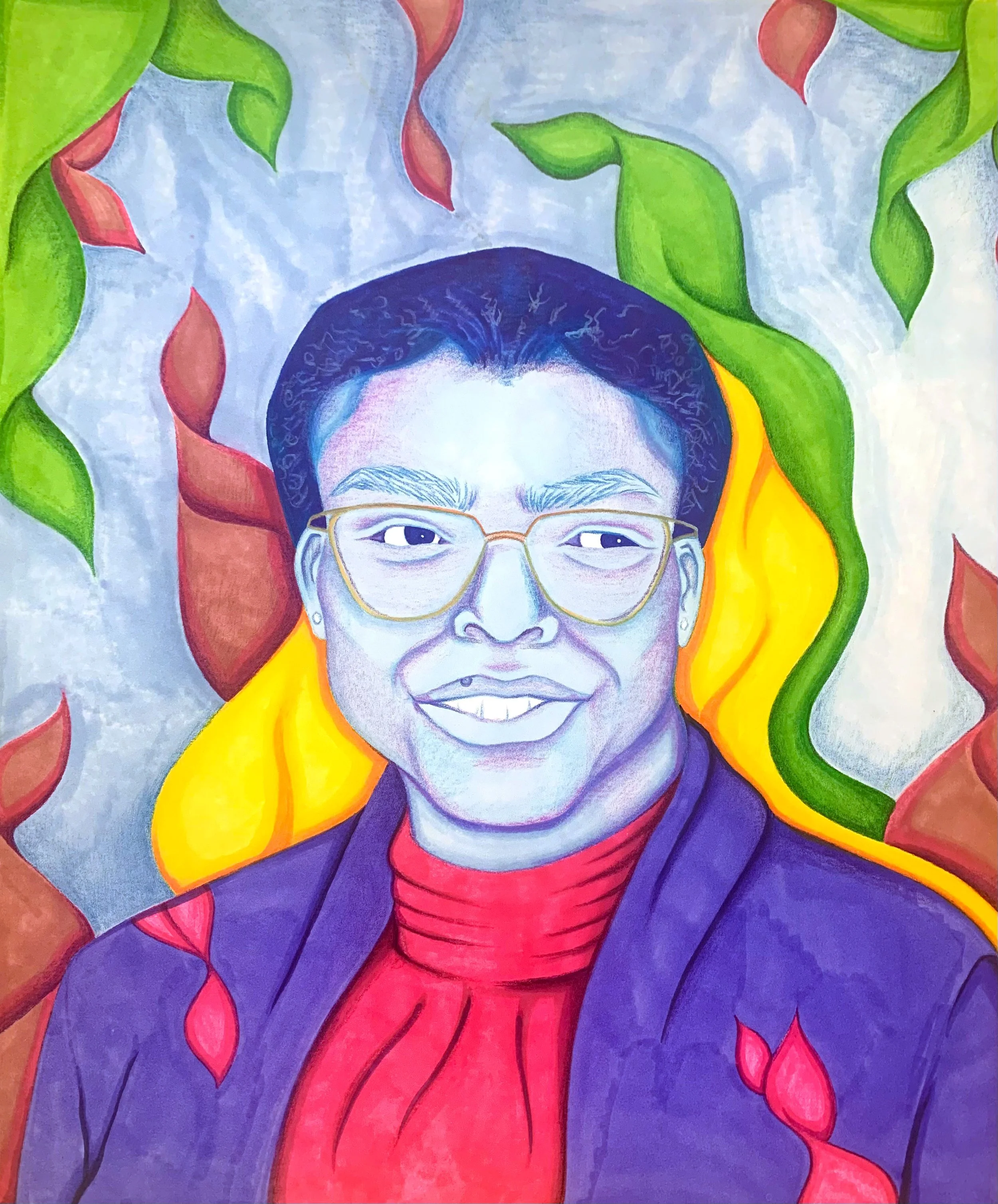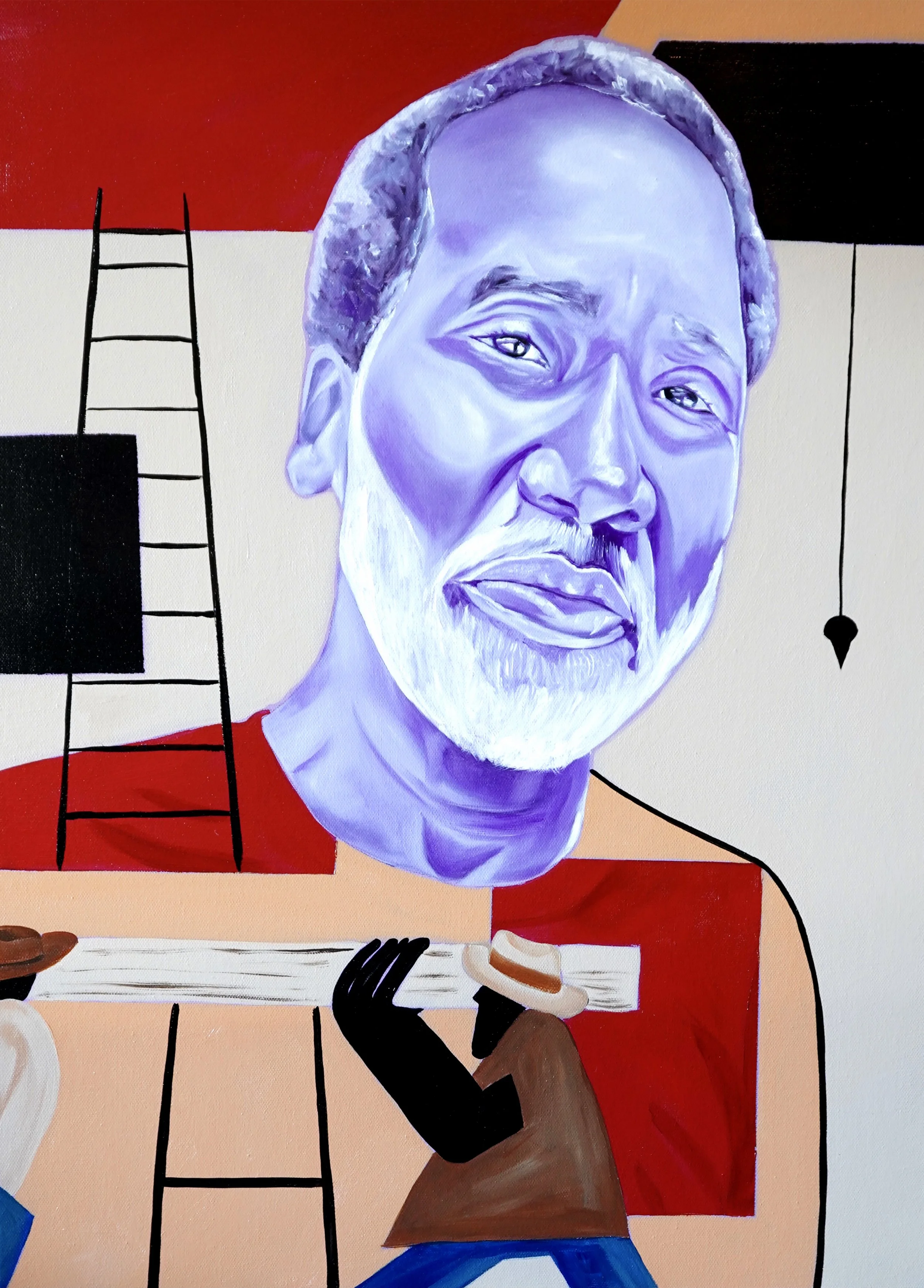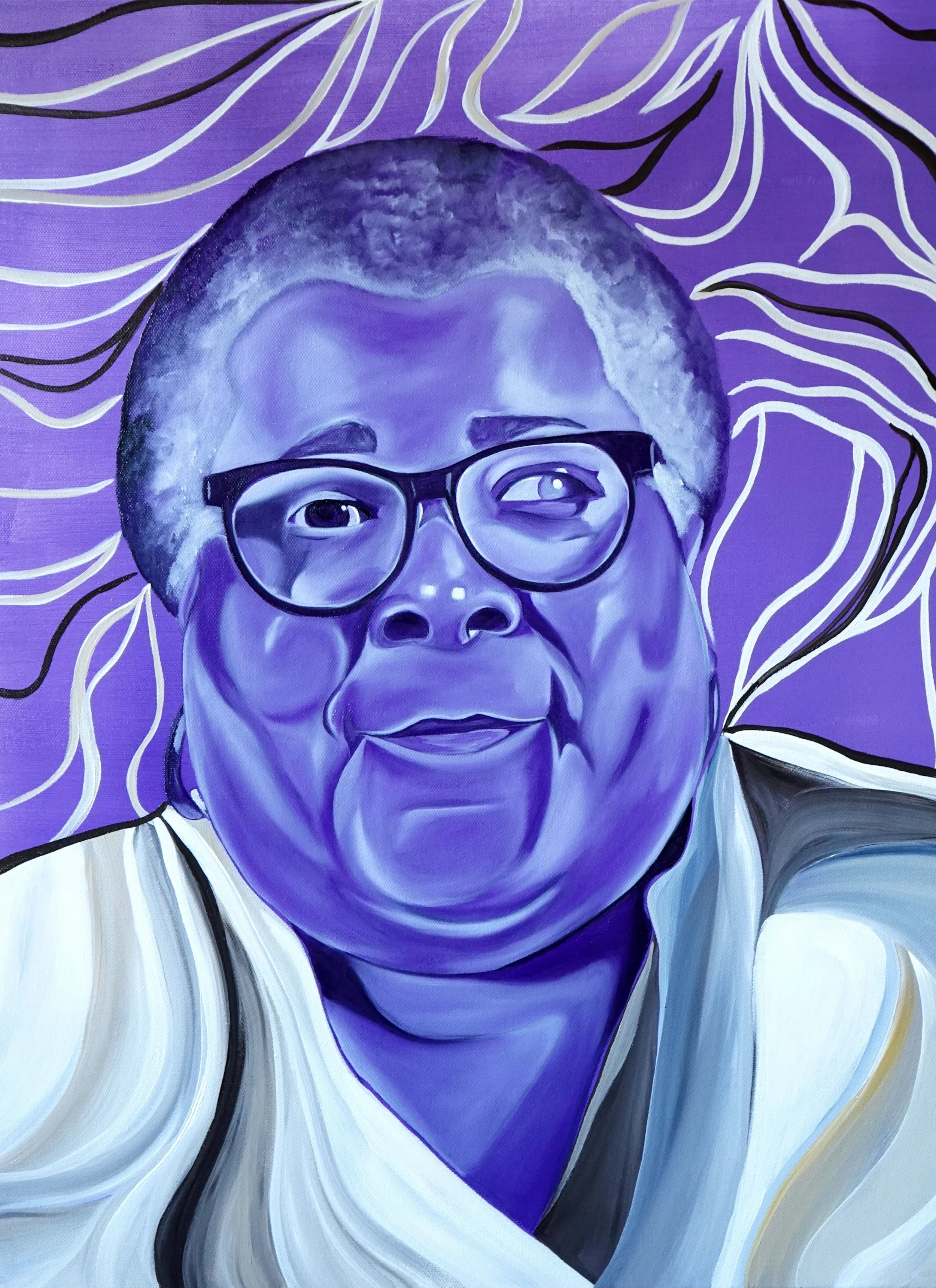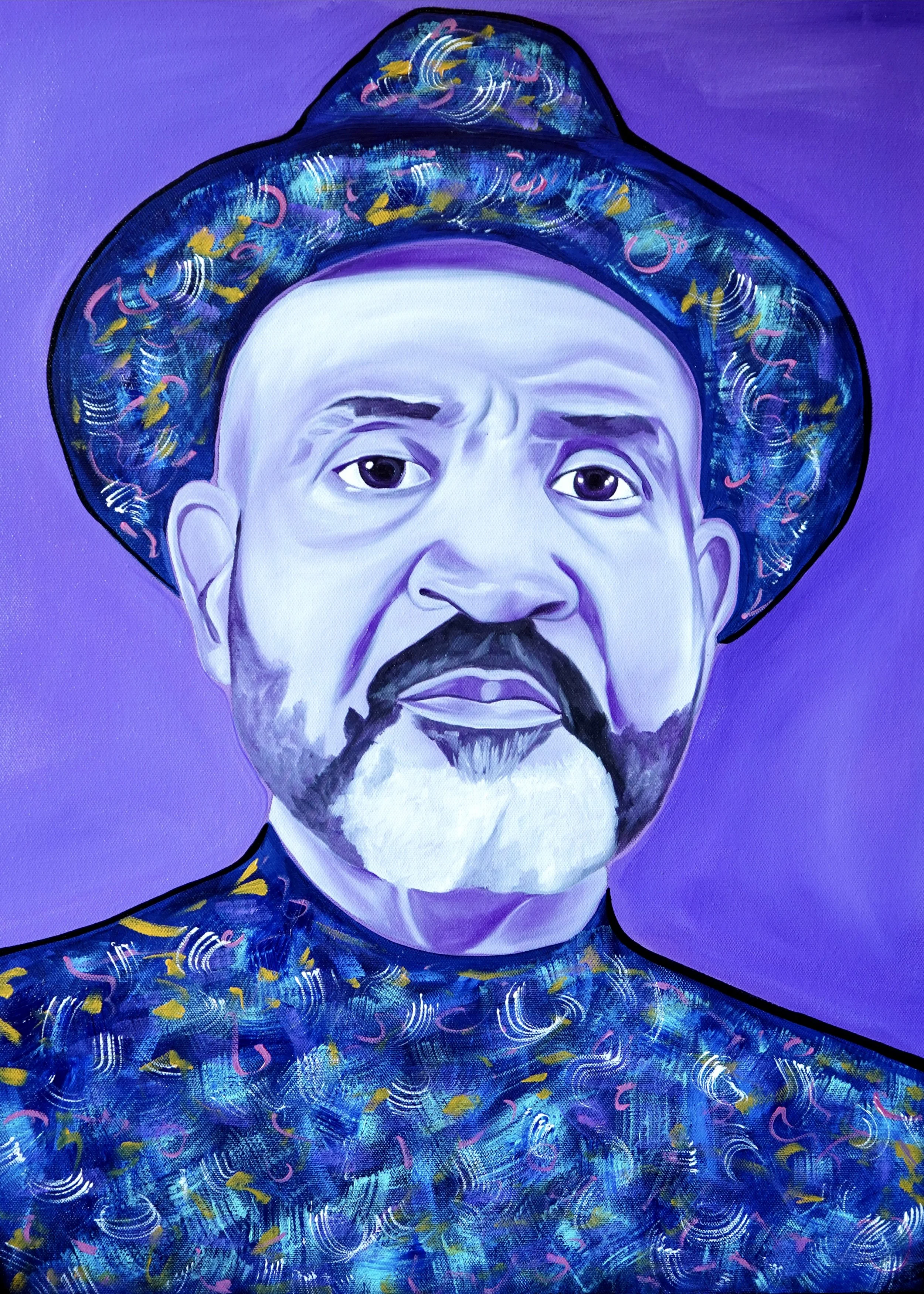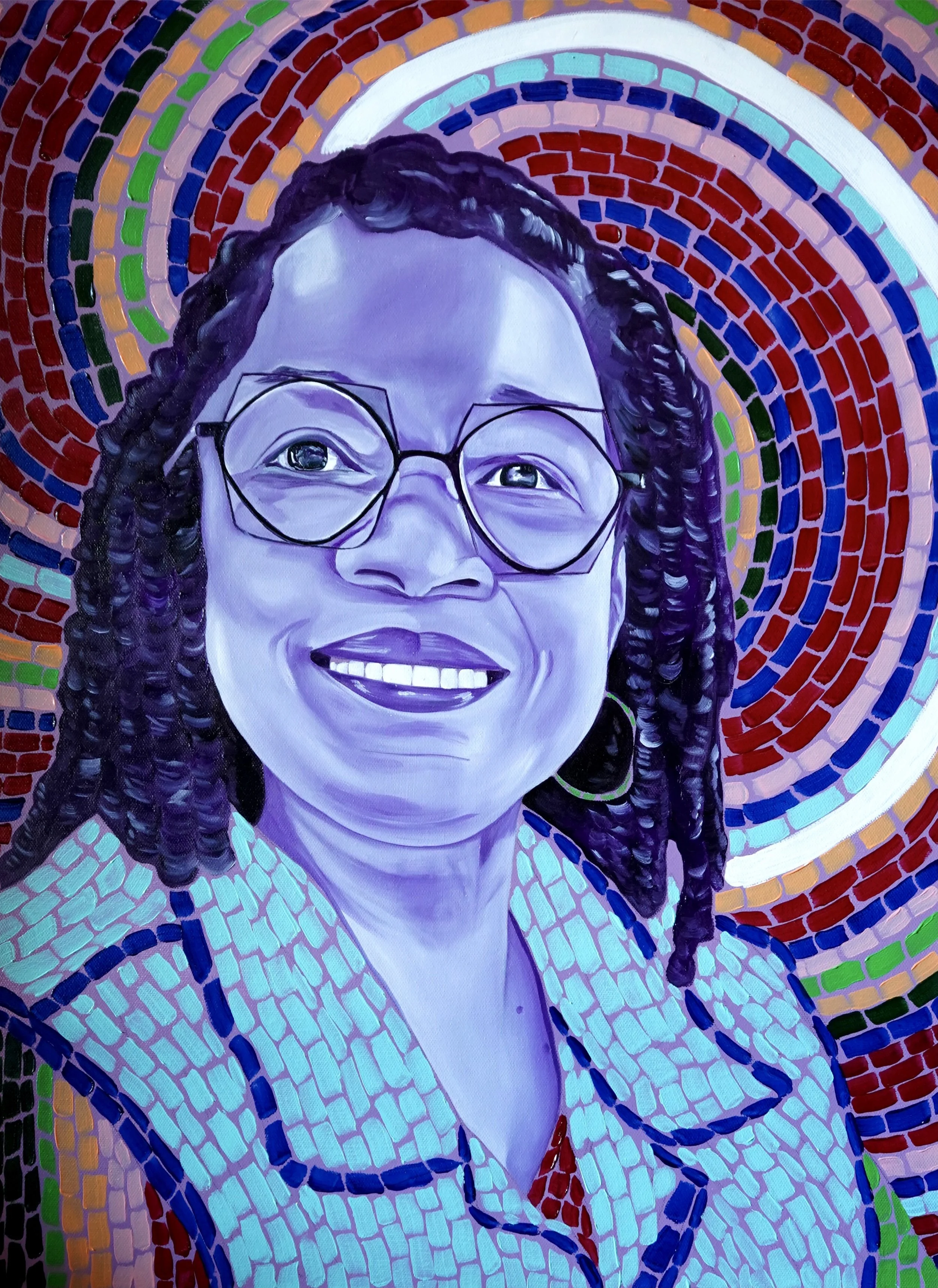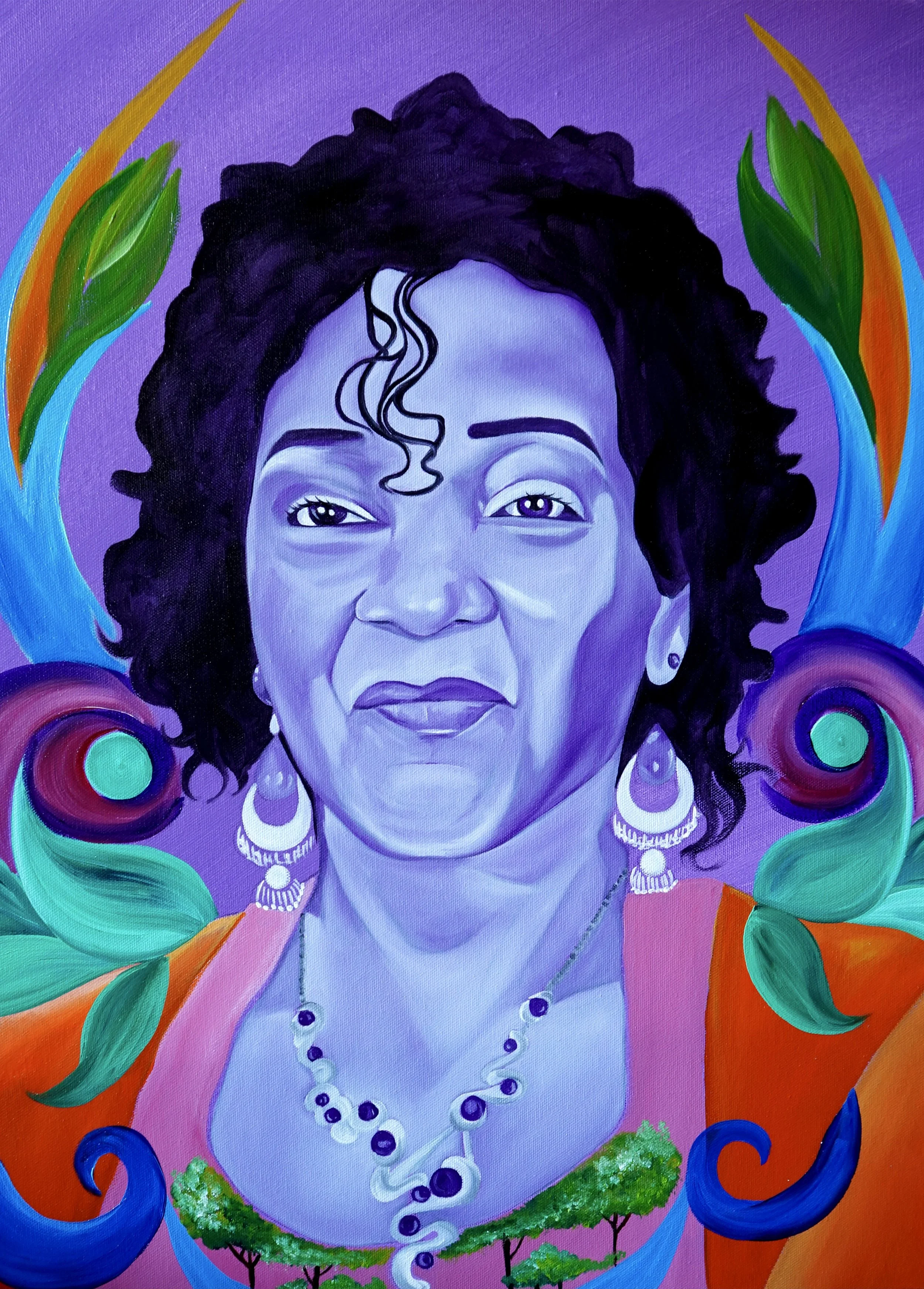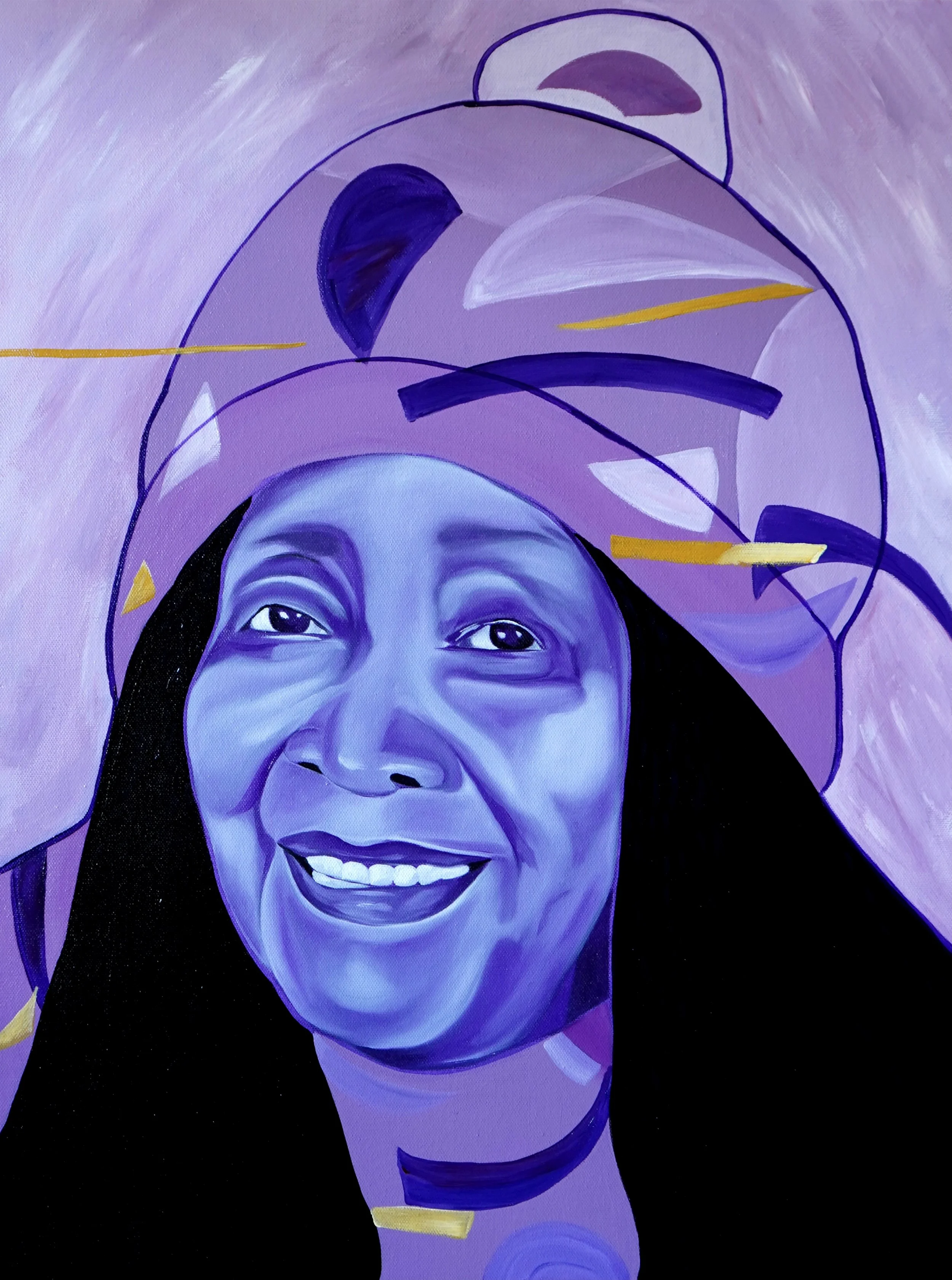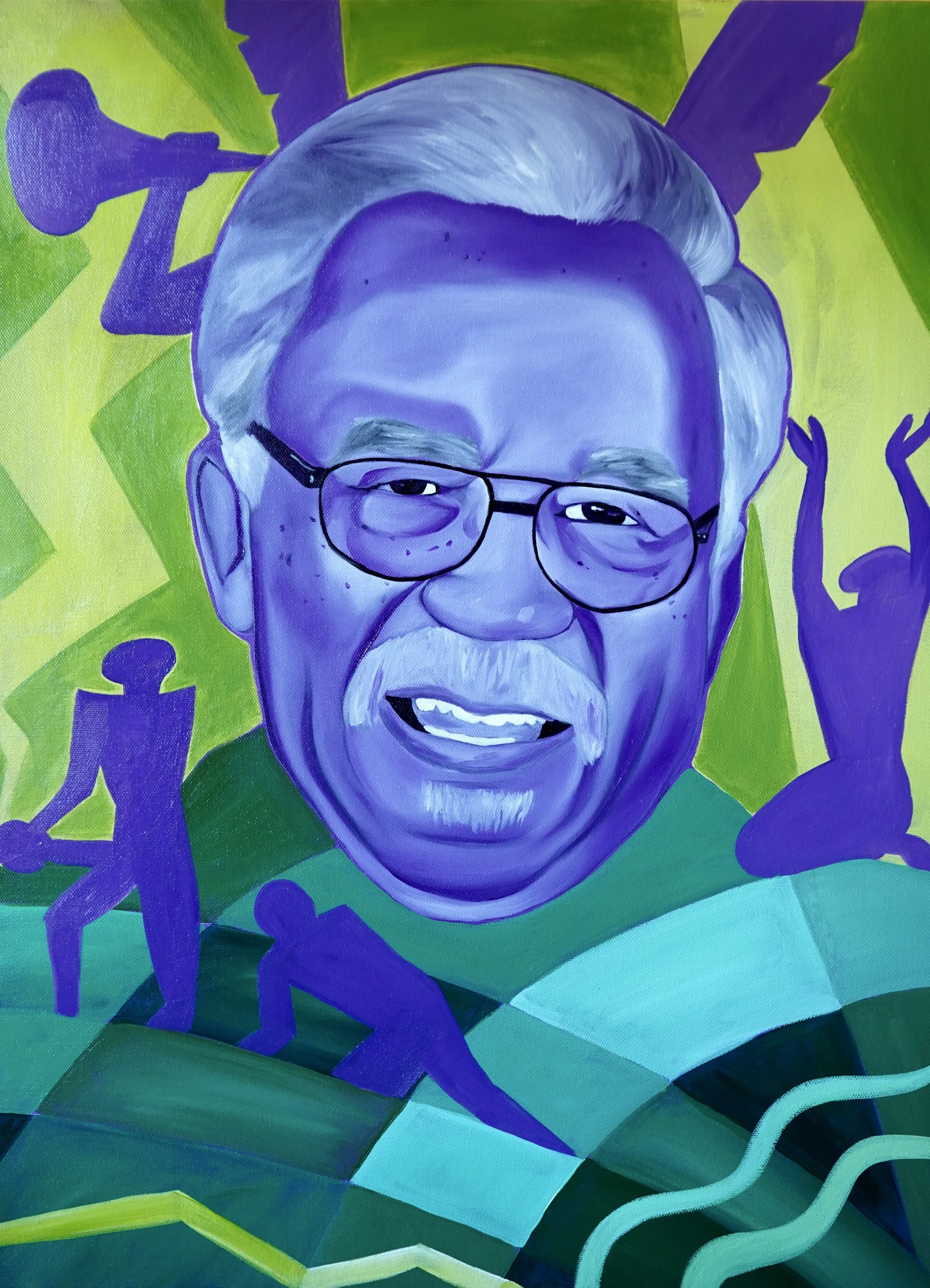MEET THE GREATRIARCHS
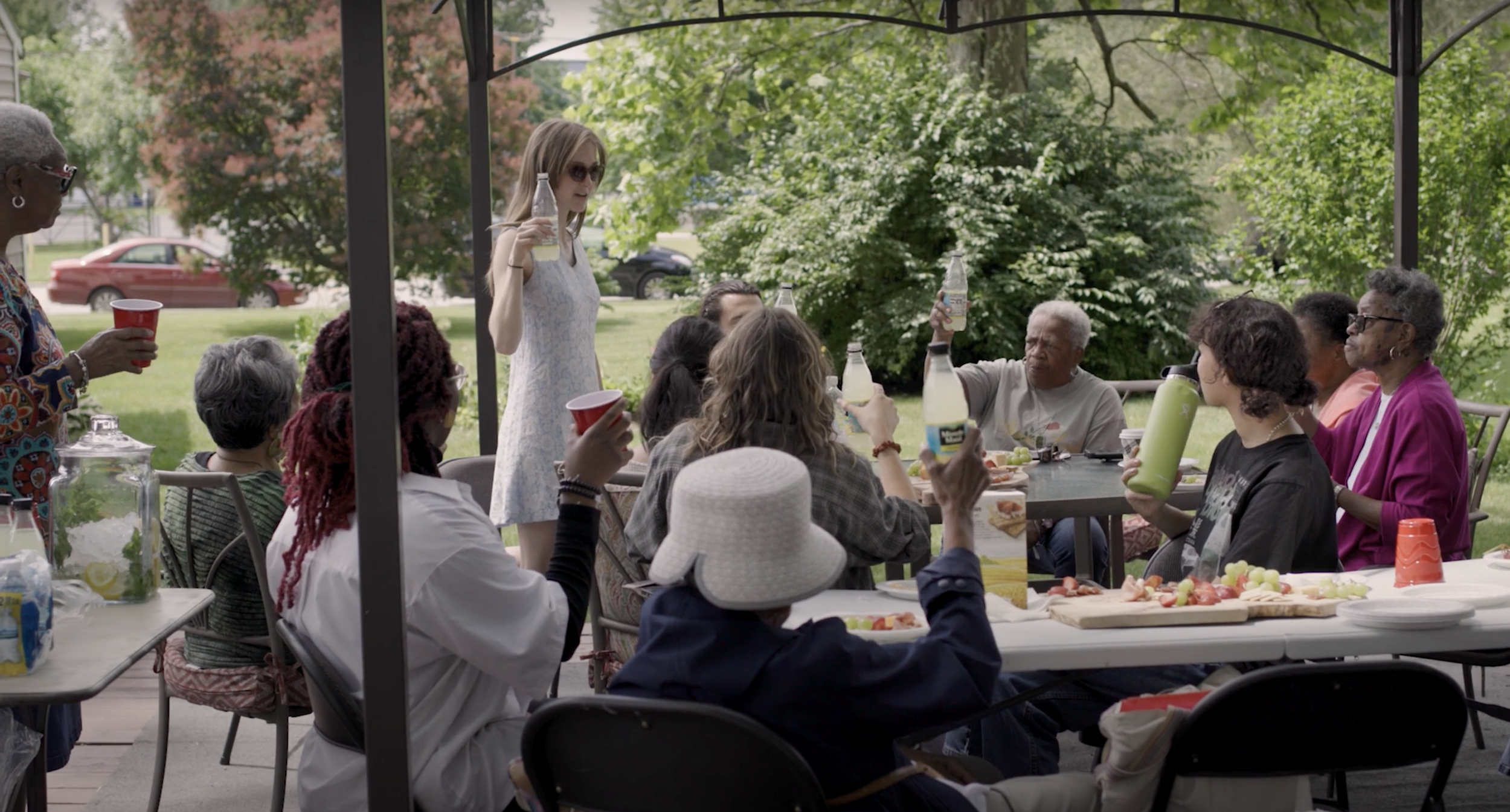
The Greatriarchs are long-term residents of the Martindale-Brightwood neighborhood. They are leaders, nurturers, mentors, and friends to the old and new residents of their neighborhood. Artist Abi Ogle spent time with each Greatriarch and painted a large-scale portrait of each one to be displayed outside along the 16th Street corridor in Martindale-Brightwood. Starting in 2023, artists Danielle Harrell, Cierra Johnson, and Tashema Davis took on the project of creating portraits of each new Greatriarch. The Greatriarch project reminds us that every neighbor has a story that deserves to be heard.
As the Harrison Center has continued working in Martindale-Brightwood, the Greatriarchs have served as advisors for our work and connected us more deeply to the community. Over the past few years, we’ve had all sorts of fun together, from monthly luncheons to field trips to the mayor’s office to shooting a music video. We always have a good time when we’re with the Greatriarchs!
Scroll Down to meet each Greatriarch!
Henry Ossawa Tanner’s painting Flight Into Egypt allows us to see the familiar in a new way. He created work in the United States and then moved to France, where he was empowered to create beautiful and unexpected biblical depictions of hope. Similarly, Miss Carol facilitated the creation of images that told stories of hope after she moved to a new place. She grew up at 2212 Martindale Ave (now Andrew J. Brown), and after graduating from St. Agnes Academy, Father Strange hired her to work at St. Rita’s. During her time there –working as school secretary and later managing the cashier room for the weekly Catholic lottery pool– she developed a love for helping people and showing them how to help themselves. After relocating to Oakland, California, for her professional career, she created the Positive Images Calendar to tell stories of hope in the community. Upon retiring to Indianapolis, she brought the Positive Images Calendar and has been sharing the encouragement of the project with her community ever since. The blues of this piece emanate forth, glowing softly, moving from darkness into light. The viewer’s eyes follow a path that may be winding but leads to hope and the ability to share joy.
Portrait Inspiration: Henry Ossawa Tanner, Flight Into Egypt, 1923.
Portrait by: Abi Ogle
Charles Tony Knight is someone who deeply cares for his community. He has dedicated his life to the education of children and has thoughtfully sought to create spaces in which learning and care are fostered for those in the Indianapolis educational system. Knight has been recognized by his community with awards including (but not limited to): the 1994 Martin Luther King Jr. Human Rights Award for Community Service, the 1994 Indiana University School of Law, Indianapolis Senior Service Award, and a 1993 nomination for the United Way of Central Indiana’s Volunteer of the Year Award.
Portrait Inspiration: Beauford Delaney, Self-Portrait, 1962.
This portrait by Beauford Delaney was chosen because its seemingly chaotic strokes come together to make a cohesive collection that becomes the background and leaks into the foreground. Knight’s story, as someone who cares for his community, expands out of single actions and creates a collection of achievements that help grow and care for the neighborhood, one person at a time.
Portrait by: Abi Ogle
Duane Jiles is beloved by his neighbors and known for the way he serves his community. Whether it’s giving someone a lift to an appointment, listening to a family story, or helping with home improvements, Duane is always ready to help. His portrait is rooted in the idea that when an individual takes the time to invest in those around them, a community of generosity and care grows.
Portrait Inspiration: Eldzier Cortor, Trio Assemblage #1 / Composition III, Circa 1950.
Eldzier Cortor’s Trio Assemblage #1, Composition III, is tied together with bodily forms that encompass unlikely marks, colors, and forms. All of these interesting individual pieces come together in a beautifully cohesive composition.
Portrait by: Abi Ogle
Upon hearing Ms. Eunice’s compelling story of history and journalism, Barkley Leonnard Hendrick’s painting Lawdy Mama came to mind. Elevated with a gold background, the figure’s gaze holds the viewer in an unafraid and watchful way. Hendricks made leading contributions to Black portraiture and conceptualism, and Eunice Trotter – someone who came from a pioneer Black family with roots in Indiana dating back to the 1790s. She began working at The Indianapolis Recorder during her high school years and, in 1987, purchased controlling interest in that newspaper (one of the oldest African-American newspapers in the country). She was the first African American editor at The Indianapolis Star and held editing and reporting positions at several other newspapers, including The New York Post, Florida Today, the Palm Beach Post, and the Lafayette Journal and Courier. Her prolific career includes numerous reporting and writing accolades, including the Indiana Historical Society’s Dorothy Riker Historian Award. In 2017, she was inducted into the Indiana Journalism Hall of Fame. She recently published her first book, “Black in Indiana,” which received a first-place award from the Indiana Press Women’s Club. The book also placed first in the 2021 Federation of Press Women’s competition. Like Hendricks, Trotter has made an incredible mark on her community with a reach that goes beyond her neighborhood and into the world of journalism.
Portrait Inspiration: Barkley Leonnard Hendricks, Lawdy Mama, 1969.
Portrait by: Abi Ogle
Miss Mattie believes that “Art is a beautiful thing that is meant to be shared and enjoyed with others.” Her reputation as an incredible seamstress from Martindale-Brightwood made Charles Robert Searles’ painting, In Front of the Store, a fitting parallel to Miss Mattie’s story. Through its quilt-like composition, the work comes to life with vibrant colors and careful “seams.” Miss Mattie has worked with textiles for fifty years, an interest that evolved from a 4-H course at historic School 26 and from watching her grandmother quilt. The fabric of Miss Mattie’s life has been inextricably stitched into the history of Yandes Street, the neighborhood where she and her family have lived for their entire lives. She even counts a few of the other Greatriarchs as relatives. Miss Pearl is her second cousin, and Miss Jimmie Luton is her first cousin. Since retiring from a 38-year career as an administrative assistant, she has continued generously sharing her beautiful wearable and functional pieces with friends, family, and neighbors. From masks to quilts, she works with great precision, diligence, and patience.
Portrait Inspiration: Charles Robert Searles, In Front of the Store, 1971.
Portrait by: Abi Ogle
As an accomplished professional photographer with an emphasis on producing fine art and documentary images, Bill’s portrait points us to the prolific American photographer, Gordon Parks. With great care, both men have built an extensive body of work documenting and capturing crucial times in history, Rasdell in Cuba and Parks in the United States. Both have shared moments of deep humanity and have been unafraid to tell complex stories through their own lenses. Bill’s portrait is painted in greys, black, and white to echo the monochromatic photography that Parks created, and is more geometrically oriented to reference the initial appearance of rigidity in photography that unfolds into a complex pattern of the unexpected.
portrait inspiration: Gordon Parks, Husband and Wife, Sunday Morning, Detroit, Michigan 1950.
Portrait by: Abi Ogle
Joanna LeNoir moved to Indianapolis with her mom and siblings on July 14th, 1963 to escape an abusive family situation. Today, Joanna and her family celebrate this day as Freedom Day– the day they got a fresh start. Indianapolis proved to be the perfect place for Joanna to thrive. Going back to school as an adult provided her with a long, second career as a nurse. Joanna worked at multiple hospitals and clinics, supporting patients through health problems with her caring personality. She was also involved in her community through volunteering at JTV Hill Community Center and participation with dances at St. Rita Catholic Church. Joanna is a mother to 4 children, including her daughter who passed away after a battle with cancer. Today, she is a fixture of the community, and still lives in the house her family moved into on Freedom Day many years ago.
Artist Abi Ogle referenced Rose Piper’s agonizing painting, The Death of Bessie Smith, because Ms. Joanna’s story is personal and powerful, and she wanted her inspiration to portray that. Bessie Smith was a gifted Jazz singer who died young in a car accident, the man she was with escaped unharmed; isn’t it strange how that happens? Despite her critical condition, she wasn’t admitted to the white hospital and though she did eventually get to a black hospital, she died the next day– this is just the initial layer of trauma that burdens Smith’s story.
Ogle thought about the veined hands in this painting when Ms. Joanna told about her daughter who died of lung cancer, and again, when she shared how her first daughter was born as a result of her being raped at fifteen. The Death of Bessie Smith reminded Abi that life is precious, even when other people wouldn’t necessarily see it that way; the way that the pain pulses from our brains to the tips of our fingers, lighting our veins on fire– it shows us that we’re still alive. Joanna is an incredibly wise and thoughtful woman, so it was a gift to witness the inextinguishable life that pulses through her and the words she speaks. Despite everything she’s endured, she’s been a part of this neighborhood for many years and is such a pillar of strength and life to the community around her.
Portrait Inspiration: Rose Piper, The Death of Bessie Smith, 1947
Portrait by: Abi Ogle
If you ever have a question about Martindale-Brightwood, ask Miss Pearl! Pearl was raised in the neighborhood and even graduated from the historic School 26! She loves her community well and has served in a variety of volunteer roles. She is an active member of One Voice Martindale-Brightwood as well as the Hillside Neighborhood Association. Pearl also helped CICOA identify seniors who needed a helping hand during the Safe at Home annual event, sponsored by CICOA. When Pearl was raising her two sons, she even stepped up to be a Cub Scout leader when their troop couldn’t find enough male leaders. Today, in addition to volunteering and being a grandmother, she takes excellent care of her mother (and fellow Greatriarch) Miss Jimmie.
Portrait Inspiration: Untitled, c. 1968 by Howardena Pindell, acrylic and cray-pas on canvas
Pearl is similar to this glowing piece by artist Howardena Pindell in that she’s a beautiful ember–full of an honest fire, powered by life, and refusing to give up. She’s lived in the neighborhood since childhood, actively fighting to build community and bring people together despite the difficulty of local commitment. Many of the provocative creations of Pindell work to enter into the conversation of race; I was struck by this simple piece for Pearl because as each mark is created, it becomes a community.
Both Pindell’s marks and those of Pearl’s portrait are messy and oftentimes go the wrong way, but they are together–building something greater than what one could do on its own. The colors are warm and alive while also bold and flowing; my conversation with her was something intense but important. Letting the marks capture Pearl’s fire, I wanted to portray her thoughtful introspection that I was lucky enough to catch a glimpse of. In this portrait, Pearl is in a pose that she often subconsciously struck after having said some illuminating kernel of wisdom, shedding vibrant color onto the community that she has so faithfully been a part of and–I have no doubt–will continue to do so.
Portrait by: Abi Ogle
Terri Taylor, lovingly known as “Miss Tee,” is a long time resident of Martindale-Brightwood. Terri knows seemingly everyone in the neighborhood and is known and loved by many. Part of the community since childhood, Terri attended the historic School 26. Later as a parent, Terri was an involved and active community organizer, working on the volunteer committee for JTV Hill Community Center. Terri and the team mentored children and teenagers, organized fundraisers, and worked to take care of the elderly and disabled. Today, Terri has 2 children, 4 grandchildren, and 2 great- grandchildren. Miss Tee is always up for a laugh and knows how to have a good time! You can spot her around the neighborhood, almost always dressed in purple, her favorite color.
The marks of Alma Thomas seemed appropriate as I sat listening to Ms. Terri. These marks overlap and therefore create a field, one color behind another more dominant color. “I have always had a signature color,” she said smiling. “It used to be orange, but that was back in high school. It’s been purple ever since!” Visually this happens in the portrait, the figure Is sitting on an orange chair that is behind her, while the purple marks grow and change from background to foreground. In addition to her surroundings, Terri has charming beauty marks on her face that literally create patterns on her skin–so she herself is also a work of art with physical patterns. Her sunhat becomes a halo, elevating her to the visual status of many women in art’s history that are understood as divine. “There’s been more good than bad here,” she told me. Listening to Terri talk about growing up in this neighborhood was incredible. She has shown such an interest in her neighbors despite–or perhaps because of–seeing so many people around her come and go. Terri is warm, quick to laugh, and dressed from head to toe in every imaginable shade of purple.
portrait inspiration: Alma Thomas, Autumn Leaves Fluttering in the Breeze, 1973
Portrait by: Abi Ogle
Paul Ross always dreamed of being a cowboy, but no one he knew had horses. Then one day, after volunteering to lead a local trail ride, he had a conversation with someone who noticed his natural ability with the horses and asked him if he would be interested in owning one, thus beginning a story that lead to community involvement all in collaboration with his horse, Cameo.
“It’s about telling a story.” Mr. Paul said, “You have to be willing to be a part, to pitch in, and to talk to the people in the neighborhood.” He often puts these words to action as he takes Cameo into the community to pick up trash on the streets. Not only does he try to be helpful, but Cameo acts as an invitation for people to start a friendly conversation with him. Mr. Paul is President of the Association of Black Cowboys which brings together other neighborhood horse owners, creating a community and inviting urban neighborhoods to be a part of the cowboy story. He is a roving Greatriarch, so to speak, someone who has made a choice to serve in the neighborhoods he rides in.
Jacob Lawrence’s painting, Black Cowboys seemed appropriate for Mr. Paul’s portrait for several reasons. Not only is it a related narrative, but it is alive. The horses and cows depicted vibrate with a strange vivid movement, and the lassos that are thrown around the cowboy’s shoulders and whipping around the cows echoes the movement. When Mr. Paul was riding Cameo, she was full of a will to move, her ears twitched and her legs spurred her forward with eagerness to run. Mr. Paul, though calm, also had a spark that seemed to be inspired by the life the horse brought to him. Something tangible and alive, some calling that was undeniable and spurred him to share that love with the rest of the community.
Portrait Inspiration: Black Cowboys, Jacob Lawrence, ca. 1967, Casein tempera on illustration board, 20x30”.
Portrait by: Abi Ogle
After years of silence, Mr. Larry says he is now ready to talk -- and what a compelling story he has to tell. His experience as a neighbor is unique, one that is interwoven with great strength and patient wisdom. He generously reminds all who listen that names have power, that when we pursue our own selfish agendas we ruin lives, and that there is incredible grace to be found in the most unexpected places. Seydou Keïta, a Malian photographer, would invite his subjects to curate how they would best like to be perceived in a photograph through patterns and props. Similarly, as Mr. Larry’s story unfolds, several small and complicated actions grow into a pattern that is beautiful and is a more complete picture of purpose that greatly inspires others and reminds them that life is worth living.
Portrait Inspiration: Untitled, Seydou Keïta, 1959.
Portrait by: Abi Ogle
Jimmie Luton has been an integral part of the neighborhood for as long as anyone can remember. In fact, Miss Jimmie celebrated her 102nd birthday this year! Jimmie has been a friend and older mentor to many; most of the people who know her call her Memaw out of love and respect for her. Miss Jimmie was well known for running a successful beauty salon in the neighborhood, named Jimmie’s. Many women in the community remember going to Jimmie’s as young girls to get their hair done. Miss Jimmie has a wealth of knowledge and wisdom about the community. To know Miss Jimmie is to love her, and those close to her can attest to her quick wit, ambitious attitude, and contagious smile.
In the wood block print, Sharecropper, by Elizabeth Catlett, countless strokes are cut away which reveal the light underneath. Upon conversation with neighborhood matriarch Ms. Jimmie, I knew her piece had to be something painstaking but beautiful… Something that would take several careful strokes in order to commemorate her and her recently celebrated 101st birthday. For one person Ms. Jimmie has borne witness to a century of all that life offers–both pain and beauty–it’s almost unfathomable. She has watched so much go on in her neighborhood: e.g., she used to own a beauty shop that she loved. Just like the relentless persistence of Catlett’s (and Ogle’s) marks, this inspiring matriarch and her family members have been long-time members of the community and will continue to be.
portrait inspiration: Sharecropper, by Elizabeth Catlett, 1952.
Portrait by: Abi Ogle
Here, artist Abi Ogle features a portrait of the Hillside Neighborhood Association President, Michael–better known as Willie–Hawkins. He’s incredibly kind and his eyes are alight with a knowing curiosity as he speaks of memories of the day Martin Luther King Jr. was assassinated and the work of Dr. Andrew J. Brown. When he shared those stories and his experiences of exploring the streets of Indy, a certain music seemed to emerge and she immediately thought of the work of Norman Lewis. The painting Twilight Sounds references the visual manifestation of jazz music, but it is also tied to the work by Lewis that very powerfully evokes conversations rooted in civil rights (Evening Rendevouz). This simultaneously pays homage to the incredible work of Lewis as an African-American male artist and evokes the visual language of vibrant maps, music, and places that connect all of us–which just might be what makes Willie’s eyes shine.
Willie Hawkins is the perfect person to tell you all about Martindale- Brightwood. He was born and raised in the area; in fact, he still lives in the family home he grew up in on Andrew J. Brown Blvd. Growing up, Willie loved playing sports, doing crafts, and learning scripture at the local JTV Hill Community Center and Edna Martin Christian Center. Attending School 26 was also a highlight of Willie’s childhood. As an adult, Willie worked at Ford Motor Company. His love for his neighborhood manifested itself through countless hours of service. He volunteered with groups such as Troop 199 and Operation BreadBasket, and currently serves as the President of the Hillside Neighborhood Association. He is quick to crack a joke, share about the neighborhood, or lend a helping hand.
Portrait Inspiration: Norman Lewis, Twilight Sounds, 1947
Portrait by: Abi Ogle
Shirley Webster is not slowing down from the busy life of service she has always had. Through countless hours of volunteering she has touched seemingly every corner of her neighborhood. Shirley has held numerous positions such as president of the Hillside Neighborhood Association, president of the Greater Citizens Coalition of Martindale-Brightwood (GCCMB), president of the Community Development Corporation, and Coordinator of the Golden Agers. Those who know Shirley know she is quick to share stories, but even quicker to lend a listening ear and give helpful advice. Shirley and her husband Paul are still active community members and are devoted church members. Shirley has 7 children, 14 grandchildren, 44 great-grandchildren, and 1 great-great grandchild!
When portrait artist Abi Ogle first saw the vivacious Mrs. Shirley, the first thing that caught her attention was her t-shirt; it was simple yet bold with a line drawing of Harriet Tubman, reading “FEARLESS” below. Though their conversation was often political, Mrs. Shirley was incredibly thoughtful and kind; Ogle appreciated what she had to say. Ever speaking truth, she kept returning to the idea that patience and learning to be wise were things that were incredibly important. She said often that although she is grateful for the people around her and the life that she has, it was not the right path; there were many things that she wished she would have been more careful about and had done better.
The combination of her first impression of Mrs. Shirley–thanks to her shirt–and the continued conversation of life in our current climate lead Ogle to the artist Betye Saar, an African-American woman artist whose work enters the conversation of history, memory, and nostalgia. Saar’s work can be jarring as it mixes surreal, symbolic imagery with a folk art aesthetic by reclaiming stereotypes from folk culture and advertising; though this portrait isn’t directly connecting to Saar’s content, it shares the same visual language used in her piece Personae. Similar to Mrs. Shirley, Personae is initially curious, the dots on the outside are quick to draw the viewer in and ask them to get closer, only to discover that there is much more than meets the eye.
Portrait Inspiration: Betye Saar, Personae, 1996, Wood, bone, ceramic, metal and glass
Portrait by: Abi Ogle
Earl Cantrell has been a part of the Hillside neighborhood since 1994 when his motorcycle club, the Rough Riders, secured a clubhouse at 17th and Alvord. The Rough Riders, at one point in time, had over eighty-seven members, some of which were several sets of brothers. This created a unique environment that allowed for a tightly-knit group to be formed. Not only were the members closely related, but they often invited the community into their space by hosting dances that would draw hundreds of people, raising money for charity, and renting the clubhouse for private events. Though there are only twenty members left in the club, a wealth of memories and shared experiences have grown from what was once only an idea of a club mentioned in a garage.
Artist Abi Ogle chose to reference Jacob Lawrence’s Studio Corner (1936) in Mr. Earl’s portrait because this corner of the room feels active. It has frames on the wall, a box on the floor, the person who occupies that space is in motion, collecting, changing, growing, building, and all we see is one small corner of the life lived. Similarly, Mr. Earl has been a part of the community for a long time, traveling and collecting stories from his motorcycle adventures and bringing them back home to his corner of the world – Indianapolis.
Portrait Inspiration: Studio Corner by Jacob Lawrence, 1936.
Portrait by: Abi Ogle
Rain or shine, Eleyes Reeves can be seen gliding gracefully through the neighborhood on her iconic pink bike, her hat waving in the wind. As a long term resident of Indianapolis, she has strengthened the community by encouraging young artists and inviting them into neighborhood history by unearthing forgotten narratives. She is deeply interested in learning other people’s stories and backgrounds. Eleyes is a woman of many talents. Her creative ideas are endless, as she writes plays, draws portraits, and connects people to opportunities. Eleyes inspires others to get out and bike around the neighborhood. She is always eager to wave at those passing by, or to have a conversation about the projects she is a part of.
This piece was important for artist Abi Ogle to incorporate into Ms. Eleyes’s portrait because of the strong female presence that is both narrative and tied to vernacular practice. Faith Ringgold’s work is hand made, and tied to powerful history. Miss Eleyes is someone who is always adventuring into the next story with open arms, but is also looking back to the history that came before her in order to share stories.
Portrait Inspiration: Coming to Jones Road Tanka #1 Harriet Tubman, Faith Ringgold, 2010, Acrylic on canvas with pieced fabric border, 65x44”.
Portrait by: Abi Ogle
Mr. Earl and Mrs. Eunice Griffin are Greatriachs because they dedicated their lives to loving the children of the neighborhood, fostering the adults, and being present. While the Griffins no longer have the strength to tell their story, Hillside neighbors testify for them. They boast that the Griffins are the oldest married couple in the neighborhood–married over 70 years in a time when divorce is rampant. They boast that the Griffins are still together in their home in spite of poor health, which is a testimony for the neighbors. This painting invites you to learn to listen to the people in your neighborhood that can no longer share their stories fully.
This requires a new way to look and listen. This painting by Horace Pippin struck me at once regarding the Griffins because it was seemingly serene, and yet there is a forest, teeming with life, behind the stillness. It feels contemplative, but alive. The pattern that is behind the couple is reminiscent of the leaves in the background of Pippin’s painting. It hugs them, securing them in a comforting way.
Portrait Inspiration: Man on a Bench, Horace Pippin, 1946.
Portrait by: Abi Ogle
‘I try to make things better. I was raised with the idea that you should leave things better than you found them.’ Paul Webster is the kind of human who has spent years in Hillside, striving to help it grow, and acting as an agent for positive change among its members. He moved to his current home forty years ago when he and his wife, Mrs. Shirley, were married. Ever since, they have been an active part of the neighborhood and have thoughtfully engaged with those around them whether that was in church, on committees, or leading neighborhood associations. Mr. Paul was also a leader of his union and was very much interested in acting as an advocate for and listening well to those around him.
In retirement, Mr. Paul enjoys giving his wife and her friends rides as well as driving Uber. Artist Abi Ogle has tied his story to the map of the city and the excitement he shows about how things are constantly changing, moving and being made new. He recalled a time when the neighborhood was challenged with repeated drug deals and violence. But he chose to stay in his neighborhood because he had invested in it, and it is where their family home was created and fostered. Mr. Paul has watched the neighborhood evolve over the last few decades and has grown with it, through all the pains and joys that accompany that.
Ogle chose to reference Jonah and the Whale by David Driskell because of Mr. Paul’s involvement in the church community. Not only is the narrative of Jonah and the Whale a story of unexpected choices and the necessity to love a community, but the piece itself is a web of marks. The way that the lines curve and change, similar to the roads that Mr. Paul travels on during his work with Uber, reminded Ogle of how his involvement in the community has changed. It has been something unexpected and beautiful, and when seen from a further view, it becomes a cohesive whole composed of different strokes and strange interwoven paths.
Portrait Inspiration: Jonah in the Whale, David Driskell, 1966.
Portrait by: Abi Ogle
Ron Lovett grew up in Martindale-Brightwood, moved away, and then came back to be a part of the neighborhood. Ron was thankful for how he was brought up by the elders of the community, so when he returned, he, in turn, cared for the neighbors who had raised him through his career as a firefighter. Each person, whether someone in prison, someone experiencing homelessness, or someone in danger, became part of his community—one of his people. Ron’s leadership helped calm people in emergencies because they recognized him as someone they could trust. Ron continues to be involved in the neighborhood as a leader and hard worker.
Aspects of Negro Life: From Slavery Through Reconstruction by Aaron Douglas (1934), was important in reference to Mr. Ron’s portrait because of his sense of community. Similar to the painting, light radiates from the scene, and yet there are darker truths underneath the original narrative. Though there is beauty and community, there are hard truths casting shadows. This was increasingly apparent as Mr. Ron spoke about trauma and the heartache that comes with living long-term in a community, witnessing gentrification, and neighborhood deaths.
Portrait by: Abi Ogle
Aster is a woman with a lot of faith. Each time she has needed anything in the community, she said the Lord has provided. She is the founder of Felege Hiywot, a community garden whose mission is to serve the urban youths of Indianapolis. During our time together, she talked about a giant tree that stands outside the center, affectionately referred to as “The Peace Tree.” This is the place where she would read aloud to youths, or where they would find someone curled up there, asleep when they opened the center in the morning. She talked about how important plants are and how we can share and grow alongside one another if only we will take the time to have faith and trust that everything needed will come when the time is right.
Portrait Inspiration: Celebration, Charles Searles, 1975.
Portrait by: Abi Ogle
Abie Robinson is a man driven by a sense of purpose. The disillusionment he felt as a young man was challenged by the messages of Dr. King, who proclaimed that love would conquer all. The activism and community orientation that was present in the neighborhood, especially in its churches, intersected with Abie’s vision for a better, more just and equal nation. It was a particular speech, by Robert Kennedy, that stuck with him and influenced the course of his life.
When Abie returned to the park where that speech was made, now Kennedy King Park, he was overcome with the feeling of being there years earlier, on the night that Kennedy announced the assassination of Dr. King to a crowd of people. Abie recognized this spiritual connection to the place as part of his calling, to build up the community through that very park. He started working for Indy Parks, later becoming the director, and he was able to help his neighbors through a variety of programs, including a food pantry and a senior center.
As a kid, Abie used to spend every weekend roller skating in the neighborhood, and you can still find him at a local rink nearly every Sunday night. He brought his skates back to the streets for PreEnact Indy, where a temporary rink was set up in a parking lot to remind the community of its old pastime. Abie continues to seek out joy and optimism. Having fun and enjoying time with family are the main points on the agenda for after he retires this year.
Bob Thompson is referenced in Abie’s portrait because of the action as well as the primary colors in this piece. These evoke Abie’s bright and youthful spirit, that sweeps people up as he speeds past.
Portrait Inspiration: The Circus, Bob Thompson, 1963.
Portrait by: Abi Ogle
Lee Means, who celebrated his seventieth birthday this year, started attending New Bethel around the age of four years old and has made the church an integral part of his life ever since. He remembers with fondness the route from his house to the church building that he would walk as a teenager— on his way to choir practice, cub scouts, or the broadcast from the Southern Christian Leadership Conference that aired every Sunday night. Lee was a natural leader, and once he returned from the military, his pastor recognized Lee’s energy and capacity for bringing people together. He promptly started a recreation program at the church’s new gym and called on eighteen other fellowships in the area to join the league.
His love for the church came hand in hand with his passion for civil rights. His teenage years, which coincided with the height of the Civil Rights Movement, made him turn towards his community, where he sought to invest his life. Decades later, he remains a pillar in his family, his neighborhood, and at New Bethel. Lee’s presence in the neighborhood and in his beloved church has been one of enthusiasm and dedication. He believes that the neighborhood is full of both history and opportunity, and that the area churches, some that have existed for more than a century, are in an important position, poised to invite new neighbors into their spiritually connected community.
From president of the youth choir to hosting the Gospel Fest— another call on his leadership ability to bring different groups together— music has been another mainstay throughout Lee’s life. Through referencing Felrath Hines’s painting Mahler, the background of Lee’s portrait is full of bold movements and colors are reminiscent of the vibrant songs that are so near and dear to his heart.
Portrait Inspiration: Felrath Hines, Mahler, 58" x 64", 1992 (unfinished).
Portrait by: Abi Ogle
When a tree is cut down, a series of concentric circles is made visible recording each year that the tree has been alive. Lula Hillard’s story is one that is full of such circles, hidden within each ring are the choices to grow and build and make beautiful -- something that brings people together and provides a space for delight and rest in its shade. From her early choices to follow in her mother’s footsteps and buy her own house in which to raise her children, to her presence in her family’s life, and her endeavors to be a good neighbor, it is clear that Lula cares deeply for justice and relationship.
Portrait by: Abi Ogle
Diane Ivey is soft spoken, and has a kind and gentle soul. I chose to reference Ringgold’s sunflower quilt for multiple reasons for inspiration for Diane Ivey. When taking her picture, she was wearing a sunflower shirt and expressed her appreciation for the outdoors. She also conversed about how important it is to preserve the past in the present but still make something new. Ringgold often did this in her quilts, and in the sunflower piece, she referenced Vincent van Gogh.
Portrait by: Danielle Harrell
Thank you to MIBOR for their support in the creation of this portrait.
Jacklyn is a leader, and there's a sense of duality to her. She is extremely kind. She is fierce and passionate. Her fiery personality led me to Norman Lewis’s Title Unknown (March on Washington), an abstract expressionist painting depicting the joy of a carnival or the rage of a malicious riot. I think the coolness of the blue and the intense reds and oranges easily represent this part of Jacklyn’s personality: you don’t want to mess with her.
Portrait by: Danielle Harrell
Thank you to MIBOR for their support in the creation of this portrait.
Ms. Linda Belton is a local crochet artist who sells her work during First Fridays at the Harrison Center. Linda’s interest in fiber arts led me to discover work by Xenobia Bailey, specifically her work that involves the repetition of multicolored concentric circles. I felt like this pattern was a good fit for Linda because it expresses her bright, youthful, and creative energy, as well as mimics the rings of a tree trunk. Ms. Linda Belton’s family had a three-generational tree that meant a lot to them; as kids, they played under that tree. It was unfortunately cut down to make room for electric lines.
Portrait Inspiration: Xenobia Bailey
Portrait by: Danielle Harrell
Thank you to MIBOR for their support in the creation of this portrait.
Mary is very soft-spoken and keeps to the background. She is often around another Greatriarch, especially Shirley Webster, having a good time building relationships with her neighbors and community. Her quiet nature and involvement with others around her inspired me to include Oliver Lee Jackson’s Triptych in her portrait. The profiles of faces and figures dancing in a field of pastels felt suitable to what I knew about Mary Williams.
Portrait Inspiration: Triptych (3.20.15, 5.21.15, 6.8.15) by Oliver Lee Jackson
Portrait by: Danielle Harrell
Thank you to MIBOR for their support in the creation of this portrait.
Mr. Karl is very interested in ancestry and has no problem sharing about it. He researches in the library to find out all he can about his predecessors. His ancestors were black slaves and white slave owners. This inspired me to choose Aaron Douglass’s Into Bondage for Karl’s background. Much like Karl, Into Bondage depicts the unfortunate circumstances of slavery with underlying hope and strength. The star symbolizes the North Star from the Bible, giving hope to the person it radiates on that there will be salvation. Karl believes with unwavering faith that God has let him live for a reason.
Portrait Inspiration: Into Bondage by Aaron Douglass
Portrait by: Danielle Harrell
Thank you to MIBOR for their support in the creation of this portrait.
Terri Marshall has an online social media presence filled with images of her grandchildren and mother, as well as reminders of God’s love. Her optimism led me to choose a piece of Alma Thomas’s work. Alma Thomas liked to paint the beauty of the world around her rather than focus her artistic voice on creating a political message about the oppression of both African Americans and women.
Portrait Inspiration: Irises, Tulips, Jonquils and Crocuses by Alma Thomas
Portrait by: Danielle Harrell
Thank you to MIBOR for their support in the creation of this portrait.
Ms. Wiletta Atkins is brimming with soft power. Despite being rather reserved, she serves as President of Oak Hill Civic Association. She has a calm, dignified presence like the women in the works of Laura Wheeler Waring. Artist Cierra Johnson used the floral background elements of Waring to bring Ms. Wiletta’s poise to the foreground.
Portrait Inspiration: works of Laura Wheeler Waring
Portrait by: Cierra Johnson
Paula Brooks is in touch with her roots. She has spent years fighting for environmental justice in her neighborhood of Ransom Place and working with the Hoosier Environmental Council. She is a fierce advocate for her community and culture. Artist Cierra Johnson wanted to celebrate Ms. Paula with the Pan-African style of Lois Mailou Jones.
Portrait Inspiration: Lois Mailou Jones
Portrait by: Cierra Johnson
We are so happy to have Ms. Cynthia. She is soft-spoken and very demure, almost mysterious. I choose the abstracted works of Lilian Thomas Burwell for her background elements to reflect her mysterious and feminine demeanor.
Portrait Inspiration: Lilian Thomas Burwell
Portrait by: Cierra Johnson
Dr. Johnson has been putting faith into action her whole life. Born to a large Catholic family, she is an educator and world traveler. I choose to reference the work of Faith Ringgold for her portrait because of its connection to civil rights and storytelling. Ringgold quilts tell the story of America, and Dr. Johnson has spent years working in government to shape that history for herself and her students.
Portrait Inspiration: Faith Ringgold
Portrait by: Cierra Johnson
Ms. Delma is an outspoken advocate for her neighborhood. She is an active member of One Voice, the Martindale-Brightwood resident congress. She is bold, bright, and fierce. I choose the work of Emma Amos to reflect her vivid personality.
Portrait Inspiration: Emma Amos
Portrait by: Cierra Johnson
Mr. Classie has been a builder most of his life. He has over 40 years of construction experience, using his knowledge to build structures and communities. I choose to use elements from the work of Jacob Lawrence, whose paintings frequently depict blue-collar life in African-American communities. I'm excited to celebrate Mr. Classie and the work of many other black men who uphold our culture.
Portrait Inspiration: Jacob Lawrence
Portrait by: Cierra Johnson
Captain Kimberly Young has served IMPD for more than 30 years, most recently as Operations District Captain. Faith Ringgold's artistic style aptly encapsulates the essence of this remarkable individual. The painted quilt squares in Groovin’ High symbolize the stepping stones in her life journey, reflecting her love for color and embodying her enduring spirit and zest for adventure. Blue was chosen by the artist as the predominant color to underscore her dedication and ambition, mirror her attire, and symbolize her role as a police officer.
Portrait Inspiration:Dancing on the Washington Bridge by Faith Ringgold
Portrait by: Tashema Davis
Dr. Ladd's career began as a military photographer. He later taught at Martin University and the University of Phoenix and continues to serve the community by documenting the stories of Black veterans. Dr. Ladd emphasizes, "Veterans don't just fight in the war; we contribute in other ways." Dr. Ladd finds solace and guidance in religion, which significantly influences his social and emotional development. The circles in the portrait represent the camera lenses of photographer Gordon Parks’ in his 1968 self-portrait, and the veteran himself, Dr. Ladd.
Portrait Inspiration: Self Portrait by Gordon Parks, 1948
Portrait by: Tashema Davis
Like his father, Irvin Brimnage is artistic, handy, and committed to his community. Thus, his painting is inspired by The Builders by artist Jacob Lawrence. His use of block-like figures, bold shapes, and the prominent red in the original painting conveys a sense of strength. The block-shaped figures can be seen as pillars, representing a solid foundation within the composition. Brimmage embodies the spirit of one of those pillars; he is firmly rooted in his community and has expressed his commitment to remain there for life.
Portrait Inspiration: The Builders by Jacob Lawrence
Portrait by: Tashema Davis
Gina Fears is the convener of MOVE Martindale Brightwood. She leads with Mental Health America and previously in Recovery and Community Services at PACE The concept of recovery encompasses a spectrum of experiences, ranging from daunting and ambiguous to challenging and exquisite. Her portrait draws inspiration from Sam Gilliam's artwork, Whirlirama. Gilliam's creation resonated strongly with the desire for a painting characterized by expressive techniques. Gilliam's art captures this multifaceted essence.
Portrait Inspiration: Whirlirama by Sam Gilliam, 1969
Portrait by: Tashema Davis
Gina Lewis Alexander, retired Executive Director of Oasis of Hope CDC, believes that success is intertwined with one's ability to assist others. Gina actively advocates for her community by serving on boards and maintaining close ties with neighbors. Her dedication to this work is fueled by her motherly love, which instills in her a sense of purpose and pride. Inspired by her profound maternal bond, her portrait is influenced by Elizabeth Catlett's sculpture, Mother and Child, two distinct pieces—a mother figure and a child—designed to interlock seamlessly.
Portrait Inspiration: Mother and Child by Elizabeth Catlett
Portrait by: Tashema Davis
Linda Minter is a neighborhood advocate who supports family values and community welfare. Her profound faith resonates in her daily life, and her distinctive red hijab mirrors her vibrant persona. The inspiration for this portrait stems from abstract artist Mavis Iona Pusey. As many Muslims consider visual depictions potentially idolatrous, Pusey's abstract style serves as an apt choice for this portrait. Abstraction also aligns with Minter's experiences of relocating due to demographic shifts and witnessing transformations within the Martindale Brightwood community.
Portrait Inspiration: Untitled by Mavis Pusey, 1964
Portrait by: Tashema Davis
Minister Shirley Jackson of Bridge Over Troubled Water Ministries has a favorite childhood memory of the barbershop where several generations of her family went to get their hair done. This classic aesthetic of a black-and-white barbershop floor inspired the black-and-white motif of her portrait background. The abstract painting by Lilian Thomas Burwell, Arctic Flow, resonates beautifully with the spirit of Minister Jackson's portrait.
Portrait Inspiration: Arctic Flow by Lilian Thomas Burwell
Portrait by: Tashema Davis
James "Billie" Tucker was an exceptionally talented basketball player drafted by the New York Knicks in 1979. However, racial discrimination prevented his career growth. His painting was inspired by EJ Montgomery's artwork, "Fall Winds," which serves as a poignant illustration of turmoil and resonates with the discrimination theme. This striking piece not only embodies beauty but also visually represents Tucker's journey. Through his own challenges, he channeled his bitterness into providing transformative support and guidance to others.
Portrait Inspiration: Fall Winds by EJ Montgomery
Portrait by: Tashema Davis
As a Black woman and pioneer in the broadcasting/news field, Noreen Grace Scott is proud of her professional reputation and accomplishments. Her painting was inspired by Alma W. Thomas's mosaic-like collection, “Everything is Beautiful." Its vibrant colors are arranged in a circular pattern. The irregular shapes within the piece are both interconnected and distinct, much like Ms. Scott's multifaceted contributions. Thomas' piece depicts music and evokes a sense of rhythm, referencing Scott's gift of a gramophone to the Polklore Micro-Museum.
Portrait Inspiration: Everything is Beautiful by Alma W. Thomas
Portrait by: Tashema Davis
Joanna Franklin's family legacy is McKinstrey's Ice Cream, which was on 25th Street. Her radiant smile and vibrant outfit featuring different shades of blue and exquisite turquoise jewelry evoke Minnie Evans's artistic style. Evan's bright colors and dynamic elements honor Franklin's lively spirit. Inspired by Evans' artwork which often frames the central figure with imaginative floral motifs and foliage, this painting frames Franklin's face and effectively accentuates her smile.
Portrait Inspiration: Untitled by Minnie Evans
Portrait by: Tashema Davis
Dr. Dorothy Herron exemplifies a life dedicated to making the most of every endeavor. She willingly serves and creates opportunities for those in need, embodying a spirit of adventure and embracing divinely inspired opportunities. Her painting is inspired by the artist Betty Blayton and her work titled Accepting Life Forces #3, which resonates deeply with Dr. Herron's narrative. The abstract shapes and soft pastel colors reflect her temperament; she possesses a gentle demeanor while exerting a profound impact on those around her.
Portrait Inspiration: Accepting Life Forces #3 by Betty Blayton
Portrait by: Tashema Davis
Son of civil rights leader Andrew J. Brown, Dr. Thomas Brown also became a leader in his own right, continuing the fight for freedom through Operation Breadbasket and hosting his own radio show, Harambe. This painting is inspired by this narrative of freedom and the uplifting work of Aaron Douglas, The Judgment Day. The green symbolizes growth, rebirth, and renewal, aligning with Dr. Brown's message. The vibrant artwork conveys a sense of hope, mirroring the inspiring nature of Dr. Brown's stories, which he narrates with profound optimism.
Portrait Inspiration: The Judgment Day by Aaron Douglas
Portrait by: Tashema Davis
About the Portraits
Artist Abi Ogle met with each Greatriarch to hear their stories and gather inspiration for their large-scale portrait. Starting in 2023, artists Danielle Harrell, Cierra Johnson, and Tashema Davis took on the project of creating portraits of each new Greatriarch. Each portrait includes visual themes drawn from African American art history. The portraits have been displayed both indoors and outdoors at many Indianapolis locations, including the 16th Street Corridor, the City Gallery, and Black Expo.
